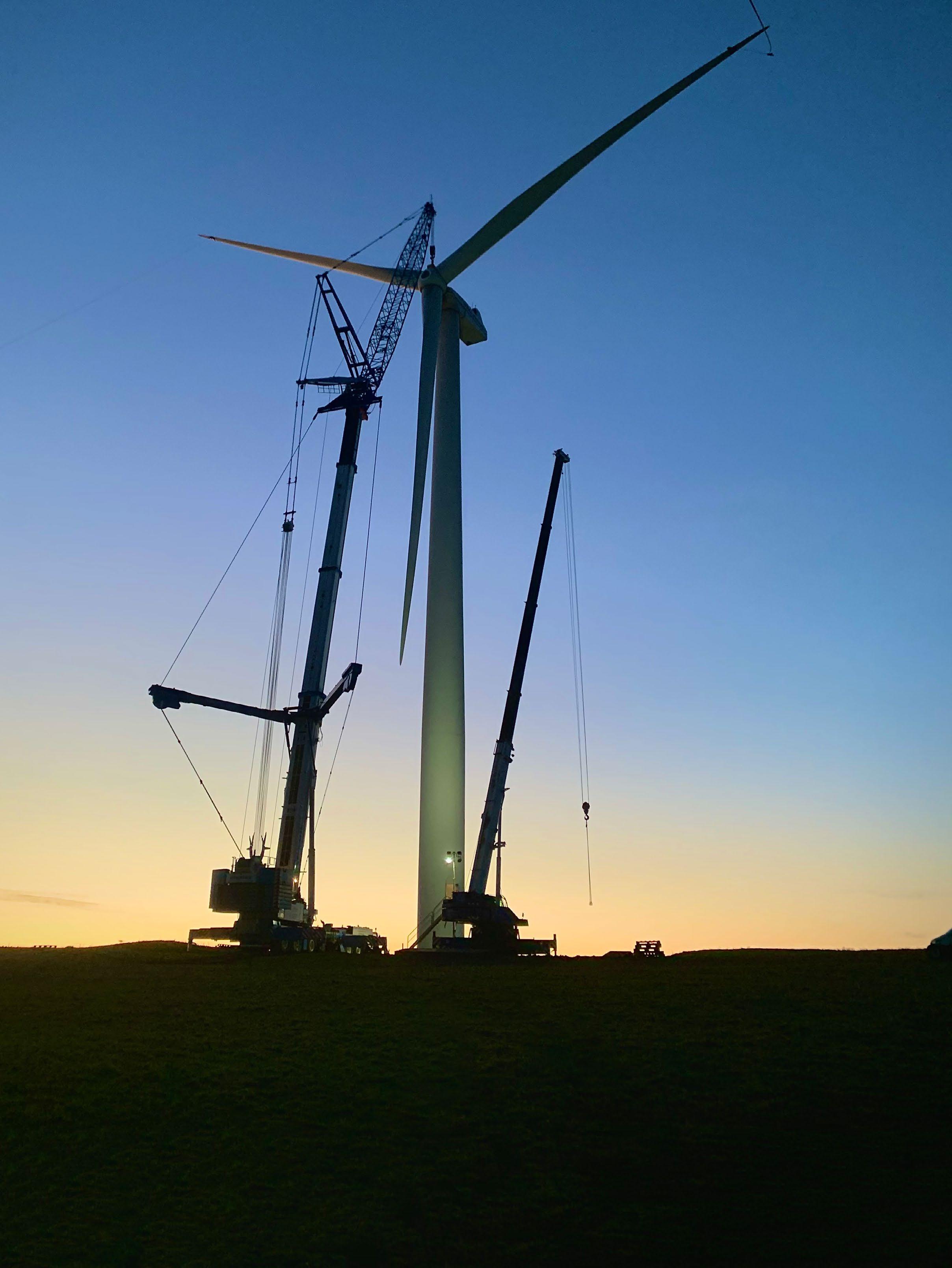




GLOBAL NEWS RenewableUK Publishes Latest EnergyPulse Insights for Offshore Wind P.8 WIND ENERGY Interview with Claire Mack – CEO of Scottish Renewables P.18 HYDROGEN & CCS Interrview with PhilipPe Kavafyan, Executive Director at Aker Horizons P.28 READ ONLINE AT RENEWABLES PUBLICATION IN ASSOCIATION WITH GLOBAL NEWS PROJECTS MAP WIND ENERGY HYDROGEN & CCS GEOTHERMAL MARINE & TIDAL ELECTRIFICATION SOLAR CONTRACTS ON THE MOVE EVENTS ISSUE 3 - MAR 2023 READ ON PAGE 4 INVESTMENT IN WIND PROPELS STRATEGIC GROWTH

COVER FEATURE
REGIONAL NEWS
PROJECTS MAP
WIND ENERGY
HYDROGEN & CCS
GEOTHERMAL MARINE & TIDAL ELECTRIFICATION SOLAR CONTRACTS ON THE MOVE EVENTS
ANA MUSAT, EXECUTIVE DIRECTOR, POLICY & ENGAGEMENT, RENEWABLEUK
The UK has led the way in renewables for some time, making it an appealing market for investment. However, changes to policy, taxes and global energy security have created new challenges in our sector that have created uncertainty and hesitancy among new investors. Reversing this recent trend to boost the UK’s competitiveness with regards to resources, supply and workforce is essential for the future of our green energy market.
So, what are some of the immediate challenges? The energy price and the Electricity Generator Levy (EGL) have both had an impact on the growth of energy production, including those in the green energy sector. These factors have destabilised the policy and regulatory environment, discouraging new investment and putting the viability of projects in development into question at a time when we should be pushing ahead. The EGL also created an unlevel playing field, giving fossil fuels an unfair advantage, as oil and gas operators with a wind turbine on their installation receive a tax break of 80%, while the capital allowance deduction rate for renewable generators is limited to 18%.
On a wider scale, the effects of Liz Truss’s mini-Budget continue to be felt in renewable energy, as in several other industries. The on-going difficulties surrounding energy security – magnified by the Ukraine conflict with Russia – means that governments are looking to boost the production of homegrown energy. A third of the global economies are estimated to be in recession this year due to the combination of problems faced in the past couple of years.
Many investors are turning their attention to the US market, with the Inflation Reduction Act making this particularly attractive by offering substantial financial incentives – and the European Union is following suit. There is also significant growth predicted in China within the offshore wind market.

To restore confidence in the UK and encourage new investment, we need to take collective action. Firstly, we need sustainable pricing in order to support growth of our supply chains, job opportunities and economic activity. This should be accompanied by continually ambitious deployment, creating demand and facilitating investment in our manufacturing industries. The Crown Estate has suggested that a single 10MW wind turbine uses over £880,000 worth of steel – which has positive ramifications for industries across the UK as the capacity of wind energy expands.

CONTENTS
WISH TO CONTRIBUTE TO OUR NEXT PUBLICATION? Contact us to submit your interest daniel.hyland@ogvenergy.co.uk
P.26 P.30 P.32 P.34 P.36 P.38 P.40 P.42 3
P.4 P.8 P.14 P.16
Three60 Energy are ready to facilitate the rapid growth of renewable energy
The expanding energy sector requires know-how and dedication to meet its global goals, writes
Scott
Roy, Strategic Development
Director with energy life-cycle service company THREE60
 Energy.
Energy.
The proven experience and pedigree of established energy sector specialists will play a crucial role in meeting renewables targets across Scotland, the UK and globally during the energy transition. Both onshore and offshore wind have a significant role to play, as do enabling technologies including energy management systems and carbon capture, utilisation and storage (CCUS).
A range of capabilities will be required, including – for the offshore wind sector – marine geoscience, engineering, procurement, construction, commissioning (EPCC) and facilities management for operations and maintenance.
Also key, when looking at onshore wind, will be feasibility and site studies, design and contestable works, grid connection and contractor support.
Commitment to the energy transition will be the common denominator, and service provider and specialist energy contractor THREE60 Energy have positioned themselves well to deliver on this, offering a mix of ambition and appetite alongside a proven pedigree in the energy sector.
Solution-focused
Life-cycle solutions for the wind industry will be crucial for the significant roll-out of both onshore and offshore infrastructure, to facilitate the ambitions of the ScotWind licenses and deliver against industry targets established at both Holyrood and Westminster.
Combined market offerings are few and far between, which is why THREE60 Energy was proud to have acquired Scottish renewable company BJRE (Electrical), now THREE60 Energy Renewables, and strategically position itself to provide multi-sector capability.
Onshore wind operations and maintenance will be a major target market following this acquisition and the company's recent recognition as an ORE Catapult ‘Fit for Offshore Renewables’ provider reflects an ongoing commitment to providing sustainable resources, particularly in the face of heightened energy security needs.
Onshore project development is also important and the lifecycle of large-scale
Scott Roy Strategic Development Director
projects requires expertise through site identification, feasibility studies, surveys, substation design, contestable works, grid connection and balance of plant support. End-to-end support will provide a seamless project delivery process and, for THREE60 Energy, demonstrate a commitment to the ongoing transition to renewable energy.
Beyond wind
The carbon reduction challenge necessitates a range of inter-dependent solutions that can bring together different technologies in order to help reduce greenhouse gas emissions in their own right.
CCUS is crucial in this regard and comes with a shopping list of required technical expertise, including knowledge in subsurface, wells, EPCC and operations management. The combination of this capability portfolio will contribute significantly to the development and implementation of sector strategies through detailed studies, including licensing support, across multiple geographies.
THREE60 Energy have made it a key objective to provide a truly global solution to their clients and with offices in the UK, Norway, Malaysia, Singapore, Philippines, Australia, Taiwan and the USA, they now have the perfect base from which to drive the widespread rollout for CCUS strategies.
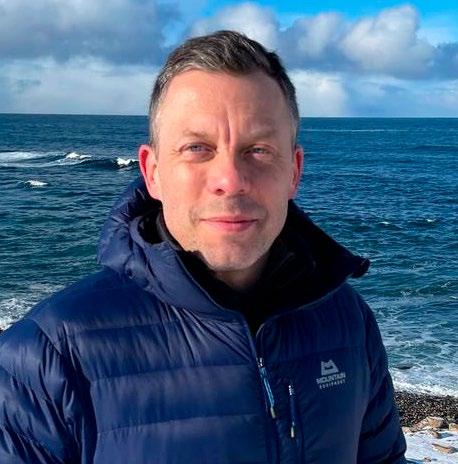
As the demand for renewable energy sources continues to grow, the development of ‘smart grid’ solutions will become increasingly important –allowing the energy generated by wind, wave and tidal to be stored in batteries and/or utilised in the production of green hydrogen.
THREE60 Energy’s partnership with the European Marine Energy Centre (EMEC) is a good example of the collaboration required going forward. Innovation leveraged by the technical expertise necessary to support testing and development of new energy technologies.
Better energy, together
The energy industry is moving towards cleaner and more sustainable solutions and established companies with experience in large-scale energy projects are being recognised as the perfect partners to help the industry deliver on these objectives.
This recognition is being put to the test in onshore and offshore wind and other emerging industries such as CCUS, Hydrogen and energy storage, which is very good news for experienced supply chain companies with a global capability. These organisations can work across multiple energy markets to help their clients reduce carbon emissions while safely running offshore infrastructure into late life, ultra late life and full decommissioning, reducing the environmental impact and facilitating the shift towards a cleaner energy mix.
THREE60 Energy have positioned themselves well to make a significant contribution to a cleaner and more sustainable future across multiple energy markets and with a truly global offering, that can benefit the national and the international decarbonisation journey.
COVER FEATURE
4 www.ogv.energy - Issue 3
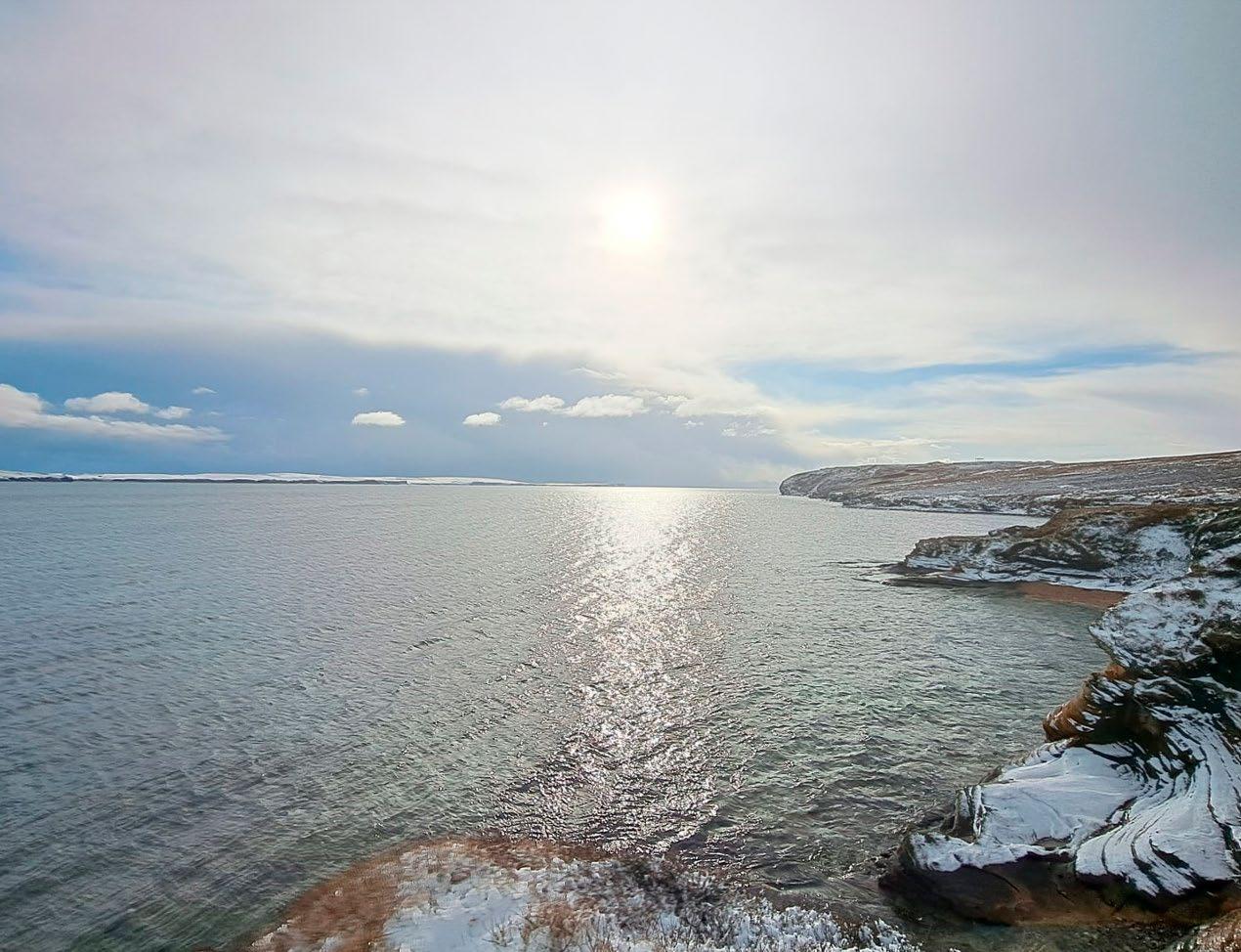




5
three60energy.com
FIBRE OPTIC TRAINING for
the onshore, offshore and renewables markets
RCP - Instrumentation and Control System specialists have made significant investment in fibre optic equipment such as fusion splicing machines, mechanical splicing kits, fibre optic ovens, optical power meters, optical microscopes and polishing equipment to terminate and test fibre optic cables, connectors junction boxes and patch panels to a very high standard.
In 2021 a dedicated fibre optic workshop was set up at our Blackburn facility to provide fibre optic training to the onshore, offshore and renewables markets.
Fibre Optic Training includes


Fusion Splicing of single mode and multimode cables using Fujikura fusion splicers, construction of bespoke fibre optic cables and connector sets, construction of circular plug/socket connectors for hazardous area use. ATEX/IECEx zone 1 connectors, cables made up with pre-potted glands and tails to facilitate ease of fitment to drilling platforms, rigs offshore and renewable assets.
Mechanical splicing – Corning and Huber + Suhner connectors, ST, SC and LC, insertion loss and cable loss measurements, testing connectors and cables for insertion loss and return loss. OTDR testing using Fujikura machines.
The format of the course starts with the theory of Fibre Optics. Safety when using Fibre Optics, FO cable selection and connector types. Stripping fibre optic cables and preparation including the use of fan out kits, the use of fibre breakout boxes and fibre optic plug socket connectors and an understanding of loss budgets for fibre optics.
Delegates will learn how to manually splice using a Corning Kit with ST, SC and LC connectors. They will learn how to measure insertion loss of splices, connectors and cables. The delegate will use a fibre optic power meter. There will also be an introduction to fusion splicing.
The training course consists of both theoretical and practical elements with approximately 75% of the course being practical exercises where the delegates get to practice the skills taught.
By the end of the course each delegate will be able to identify different types of fibre cable for use on/offshore, select the correct type of cable and connector for the application in hand, prepare and manually splice a connector onto a fibre optic core(mechanical splice), test the integrity of the connector and measure the insertion loss of the cable or cable system.
The delegates will be able to fault find and repair fibre optic cables and connectors, prepare and splice a connector onto a fibre optic core known as fusion splicing.
The course material can be created bespoke to a company’s specific requirements. The course runs over 2 days.

A certificate of competence will be issued to the delegate's employing company on successful completion of the course.
RCP provide the following site services on or offshore
Fusion Splicing of single mode and multimode cables – Fujikura fusion splicers, Construction of bespoke fibre optic cables and connector sets, Mechanical splicing –Corning and Huber + Suhner connectors, ST, SC and LC. Construction of bespoke fibre optic cables and connector sets – Insertion loss and cable loss measurement, testing connectors and cables for insertion loss and return loss.
Editorial
newsdesk@ogvenergy.co.uk


+44 (0) 1224 084 114
Advertising office@ogvenergy.co.uk
+44 (0) 1224 084 114


 Design
Ben Mckay
Journalist Tsvetana Paraskova
Design
Ben Mckay
Journalist Tsvetana Paraskova
CONTRIBUTORS
The key to faster, better decisions
RenewableUK’s EnergyPulse is the industry’s go-to market intelligence service, providing comprehensive and accurate energy data, insights, and focussed dashboards for the wind, marine, storage and green hydrogen sectors in the UK and offshore wind globally.















OUR PARTNERS


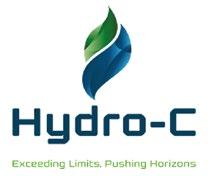
Connected to our 400+ member network our experienced team of experts research industry news, contracts, and ownership to ensure you keep grow your business agility by leveraging a suite of user-friendly, intuitive, configurable, and highly-interactive tools.


Sign up and keep your finger on the pulse of the UK and global renewable energy markets, accelerating towards a net-zero future.
We offer a wide range of competitive subscription levels that can be tailored to suit your business needs.
Contact our Head of Membership, Jeremy Sullivan or call +44(0)20 7901 3016 for a personalised consultation.

TRAVEL MANAGEMENT PARTNER




Corporate Travel Management (CTM) is a global leader in business travel management services. We drive savings, efficiency and safety to businesses and their travellers all around the world.
LOGISTICS PARTNER


Pentagon have moved freight for the oil and gas industry for nearly 50 years. This has given us an unmatched breadth of experience that allows us to implicitly understand your requirements because we know oil and gas. Whether your requirement is onshore or offshore, or drilling, oilfield services, EPC, or E&P, we can solve your logistics problem.


Disclaimer: The views and opinions published within editorials and advertisements in this OGV Energy Publication are not those of our editor or company. Whilst we have made every effort to ensure the legitimacy of the content, OGV Energy cannot accept any responsibility for errors and mistakes.
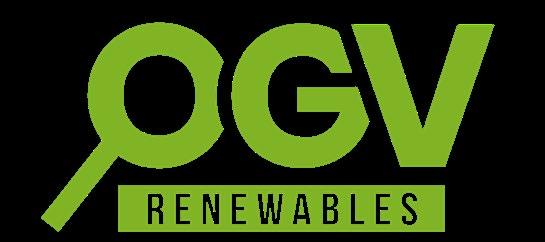
OGV ENERGY
scan de
VIEW our media pack at www.ogv.energy/advertise-with-us or
QR code ADVERTISE WITH OGV
in
RenewableUK EnergyPulse
numbers* www.renewableuk.com *Number of projects tracked as of 04/08/2022
www.renewableuk.com
RenewableUK members are enabling a just transtion to a net zero future. Focusing on continuous improvement around the three pillars of our Just Transition Tracker - People, Place and Planet These inspiring companies are a true showcase of the best that our industry has to offer.

RENEWABLEUK PUBLISHES LATEST ENERGYPULSE INSIGHTS FOR OFFSHORE WIND

RenewableUK has recently published its latest EnergyPulse Insights for Offshore Wind. It offers an invaluable overview of the market today, including forecasts of project commissioning, component demand, foundation types and ownership. Given the ongoing energy crisis and the continuing uncertainty around both energy costs and security, this is an important time for the offshore wind sector and a prime opportunity for growth. Though the UK has led the way in renewables for some time, it is vital that we maintain or even accelerate the current rate of development through further investment and innovation to retain our position at the top.
Looking at how the UK performed in 2022, it is encouraging to see that 90% of all offshore wind capacity commissioned globally was either in the UK (41%) or China (49%).
Following on were France (6%), Vietnam (2%), Japan (1%) and Italy (1%). Worldwide, offshore wind capacity reaching a final investment was down in 2022 compared to previous years. Though somewhat unsurprising given the market uncertainty and changing commodity prices, it is hoped that this trend reverses again soon.
In 2022 the UK commissioned 3.2GW of offshore wind energy, which includes the full commissioning of key sites: Hornsea Project Two, Moray East and Triton Knoll. Among all operational and future projects tracked by EnergyPulse around Britain, most of the capacity is, or is planned to be, in the North Sea off the Scottish (43,945MW) and English (33,855MW) coasts. 8,659MW of capacity will be the Irish Sea, 7,335MW in the North Atlantic, 4,428MW in the Celtic Sea and 1,600MW in the English Channel.
Looking ahead, there is the potential to deliver nearly 100GW of offshore wind energy in the UK, once projects have been fully constructed and are operational. This is an increase of 14GW from just a year ago. We are seeing developers expand capacity of their leased areas and refine areas for floating wind to create a really exciting project pipeline. As such, the average project size in the UK
continues to grow for both fixed bottom and floating offshore wind sites – the largest fixed site is predicted to exceed 4,000MW by approximately 2032. Top players in the UK market include SSE, Ørsted, Iberdrola, RWE, Vattenfall and Ocean Winds.
Shifting the spotlight onto the CfD/ICR schemes, we find 22 projects with 33 owners totalling 19.95GW in capacity already with contracts in the scheme. Approximately 7,006MW are fully commissioned from ICR, AR1 and AR2. Key projects from AR3 are either partially operational, under construction or in pre-construction. There are 5,690MW of capacity eligible for the next round, AR5, including 1,700MW at Iberdrola’s East Anglia Two and One North, as well as 2,800MW at Vattenfall’s Norfolk Zone.
Ørsted owns 4,596MW of capacity awarded between ICR and AR4, with the Hornsea Project Three secured – the company then sold 50% of Hornsea Two’s capacity to AXA IM Alts and Crédit Agricole Assurances last year. The second largest CfD portfolio is with RWE thanks to the addition of Sofia following AR3.
Of course, all this is only a snapshot of what’s happening in offshore wind around the world. EnergyPulse is tracking a total of 616 projects across Europe, 603 projects in Asia, 70 in
North America, 80 in South America, 4 in the Middle East and Africa, and 44 in Australasia. The global portfolio incorporates 1,417 projects with a total capacity of 1,174,388MW throughout 38 countries. With the majority of these projects in development, the industry is poised for a boom in operations in the not-too-distant future. This highlights the need for growth of the workforce, transferring of skills from other sectors and continued investment to facilitate even the most ambitious of net zero targets.

For further insight into the current offshore wind landscape and what the latest developments could mean for you, check out the full EnergyPulse report. Scan the QR code.
EnergyPulse - Global Offshore Wind - February 2023 - RenewableUK. RenewableUK members can access the report for free and non-members can purchase the full report for £475.

A free preview is also available. Scan the QR code below.


EnergyPulse is an exceptional resource for RenewableUK members. It provides real-time insight into the latest market trends, project achievements and more, with easy-to-use interactive dashboards.
Find out more by visiting renewableuk.com
CORPORATE PARTNER
GLOBAL news 8 www.ogv.energy - Issue 3
FIRST MINISTER OPENS SCOTTISH RENEWABLES’ OFFSHORE WIND CONFERENCE

More than 800 delegates attend ‘world class’ event Scotland is a global leader in offshore wind which is at the forefront of our energy transition.
With a short-term pipeline of 6.9GW of projects, last year’s staggering ScotWind Leasing results will see a further 28GW of projects added to our offshore timeline which has outlined the scale of things to come.
We know that offshore wind is going to transform our coastlines and the opportunities this presents are enormous. But we must put innovation at the heart of everything to ensure we have a supportive policy and planning environment, a rapid acceleration of current timescales and the infrastructure required to maximise the economic benefits for Scotland.
That’s why Scottish Renewables’ Offshore Wind Conference, sponsored by SSE Renewables, is a big deal and it’s why last month (January 25 and 26) our industry’s movers and shakers descended on the SEC in Glasgow to review the state of this thriving sector and its ambitions for the years ahead.
The sell-out event welcomed more than 800 delegates from across the UK and beyond for a fascinating two days of discussions exploring the big challenges facing the industry and how it can deliver successful projects with positive impacts for the economy, the environment and local communities.
A key date in the event calendar, this year’s twoday conference brought together a diverse set of voices to explore the future of offshore wind. From thought leadership to practical supply chain advice, the conference welcomed industry experts, developers, suppliers and stakeholders to review the state of our offshore wind aspirations.
For the first time, our new supply chain focused sessions and events allowed companies to spend invaluable and exclusive time with offshore wind tier one developers which we hope has given them a platform to grow their businesses in offshore wind. The annual Offshore Wind Conference
Dinner, sponsored by Crown Estate Scotland, saw more than 450 renewable energy professionals come together at Glasgow’s iconic Kelvingrove Art Gallery & Museum for a traditional three course Burns Supper and relaxed evening of networking.
First Minister Nicola Sturgeon opened the conference and in her ministerial address told the conference that The Scottish Government will do all it can to support the success of offshore wind and its priority must be to intensify the work it is doing together with industry to achieve our shared ambitions of a "greener, fairer, more resilient energy system".
First Minister Nicola Sturgeon speaking at the conference said: “The Scottish Government has just published our draft Energy Strategy and Just Transition Plan which reflects our commitment to accelerating the transition away from fossil fuels, and towards renewable energy.
“Your industry, and the issues you’re focusing on, could not be more important to our country’s future. For Scotland, offshore wind and the hydrogen industry offer huge industrial and economic opportunities.
“The need to accelerate our energy transition has never been more urgent and so our priority must be to intensify the work we are doing together, to achieve our shared ambitions. The Scottish Government will continue to do all that we can to support your success. The prize – if we get this right – is a greener, fairer, more resilient energy system.”
Claire Mack, Chief Executive of Scottish Renewables said: “Scottish Renewables’ Offshore Wind Conference 2023 is a world class must-attend event for anyone keen to play a role in the deployment of offshore wind.

“It’s exciting to see such a diverse set of voices coming together to look at the big challenges facing offshore wind, exploring how we can deliver our offshore wind ambitions and ensuring it is the technology at the forefront of the energy transition.
“I’m really pleased that our innovative ‘Meet-the-Buyer Business Booths’ have been a huge success and this exclusive one-to-one access will bring a new dynamic to how the supply chain is able to engage with developers and Tier 1 suppliers.

“It is clear that 2023 is going to be another huge year for offshore wind in Scotland and I’d like to thank the First Minister for taking time out of her busy schedule to give a ministerial address at today’s conference.”

GLOBAL news
OVERVIEW VIDEO
renewable news SPONSORED BY 9
Scotland is a global leader in offshore wind which is at the forefront of our energy transition.
By Tsvetana Paraskova
UK REVIEW
UK ACCELERATES DECARBONISATION EFFORTS
The UK is pushing to decarbonise industry and install more renewable energy capacity, especially from offshore wind. Renewable power generation is rising and so is support for other clean energy technologies, including hydrogen production and nuclear fusion.
The Offshore Wind Prize

Scotland’s First Minister Nicola Sturgeon said at the end of January that the Scottish Government would do all it can to support the success of offshore wind. Energy transition needs to be accelerated and priority should be put on working together with industry for achieving the shared just transition ambition, Sturgeon said at the Scottish Renewables Offshore Wind Conference in Glasgow.
“We live in a world right now where it's not difficult to see and be reminded - almost on a daily basis - of all of the challenges crowding in on us,” the first minister said.
“But we have every reason to be hopeful, optimistic and upbeat about the future - because the prize, the massive prize, if we get this right is a greener, fairer, more resilient energy system; our country here in Scotland that successfully, fairly and justly makes that transition to zero; and a country, albeit relatively small in scale, that plays a disproportionate part in helping the world save the planet for future generations.”
Offshore wind and the green hydrogen industry offer “enormous industrial and economic opportunities” for Scotland, Sturgeon said, but added that those opportunities could be maximised if there is greater collaboration across government, developers, and the supply chain.
A lot of the opportunities in the supply chain will be connected with manufacturing, therefore, Scotland needs to invest in ports to support fabrication, the first minister noted.
“The need to accelerate our energy transition, that we all recognise, and secure the benefits of our renewables assets and success, has never been a more urgent imperative. And so, our priority – our shared and collective priority - must be to intensify the work we do together to achieve those shared ambitions, for the benefit of our own generation, but also for the benefit of the generations who will come after us,” Sturgeon concluded.
Meanwhile, The Crown Estate announced in January it had signed Agreements for Lease for six offshore wind projects which could begin to generate green electricity by the
Minister for Energy and Climate Graham Stuart said:
“Offshore wind is at the heart of our goal to secure clean, affordable and resilient energy supply for all in the UK, while bringing major business, investment and job opportunities along with it.”
Offshore Wind Capacity Additions and Renewable Generation Hit Records
end of the decade and have the potential to generate around 8 gigawatts (GW) of renewable electricity, enough for more than seven million homes. Three of the six projects are located off the North Wales, Cumbria and Lancashire coast, and three are located in the North Sea off the Yorkshire and Lincolnshire coast.
The signing of the agreements and the projects planned have the potential to make a major contribution to the UK Government’s target of 50 GW of offshore wind capacity by 2030, The Crown Estate said.
“The UK’s offshore wind achievements to date are nothing short of remarkable, and this next generation of projects point to an even more exciting and dynamic future,” said Dan Labbad, CEO of The Crown Estate.
The UK government’s latest available statistics for the July-September 2022 period showed that renewable generation grew by 18% compared to the same period of 2021, due to both capacity growth – as wind generation grew by a record 2.8 GW — and more favourable weather conditions. Wind, solar, and hydropower output rose due to more favourable weather conditions for all renewable technologies, as well as increased wind and solar capacity, the Department for Business, Energy & Industrial Strategy said in December. Over one year to September, 3.4 GW in new renewable capacity was added, up by 6.9%. Most of the new capacity was in offshore wind, at 2.8 GW, continuing strong year-on-year growth that began in the first quarter of 2022.
UK wind capacity grew by 3,511 MW last year – enough to power more than 3.4 million UK homes a year, according to research by RenewableUK based on its EnergyPulse data. Offshore wind additions hit an annual high of 3,193 MW, while onshore wind capacity added 318 MW, ten times lower than offshore wind, RenewableUK said.
“Just two small turbines went operational in England in 2022, so we need to see substantial changes to enable consumers
GLOBAL news
"The need to accelerate our energy transition, that we all recognise, and secure the benefits of our renewables assets and success, has never been a more urgent imperative."
10 www.ogv.energy - Issue 3
and local communities to benefit fully from the benefits that this popular low-cost technology offers,” RenewableUK’s Chief Executive Dan McGrail said.
“That means changing the rules which skew the planning system unfairly against onshore wind in England, putting it back on a level playing field so that it can compete fairly against other clean technologies.”
Industry Calls For Budget Measures To Secure Green Growth
The low-carbon energy industry warns that the UK could lose its competitiveness in clean technology deployment and supply chain if the government does not introduce new measures to preserve Britain’s key role in renewable energy development.
The UK needs a clear government plan to continue attracting clean energy investment, five energy trade associations representing more than 750 companies wrote in a letter to the Chancellor Jeremy Hunt in early February 2023.
“Despite our industry’s commitment to the low carbon energy transition, we are concerned that there is no clear government plan to deliver green economic growth and continue attracting clean energy investment into the UK,” the chief executives of RenewableUK, Energy UK, the Nuclear Industry Association, Scottish Renewables, and Solar Energy UK wrote in the joint letter.
Currently, inflation, unfavourable exchange rates, and rising costs of raw materials and labour are pushing up prices across all sectors of the economy, including for clean energy projects, they said.
“Many developers and supply chain companies were seeing very small margins before, which will now disappear completely without a more sustainable approach to pricing clean energy solutions, and a reformed capital allowances regime,” the associations warned.
They are calling for key steps in the Spring Budget to address the potential loss of competitiveness compared to the US and the EU.
“The UK can no longer take its competitive advantage as a mature market for granted. The passage of the Inflation Reduction Act (IRA) in the US, the REPowerEU package and further interventions on state aid rules expected in the EU offer an attractive proposition for clean energy investors.”
By contrast, the UK’s Electricity Generators Levy has 0% relief for clean power generators.
“If the UK is to stay ahead in the global race for clean energy, it needs to adopt bold measures to retain and boost private investment in the energy transition,” the trade associations say.
RenewableUK’s CEO Dan McGrail said, “Investments in renewable energy and new supply chains may dry up unless the Chancellor takes decisive action and implements the key measures which we have set out in our letter to secure tens of thousands of high quality jobs and attract billions in private investment.”


Hydrogen, Industry Decarbonisation and Nuclear Fusion
The Environment Agency published on 3 February regulatory guidance on the production of hydrogen from methane with carbon capture, otherwise known as ‘blue’ hydrogen. Operators wishing to produce ‘blue’ hydrogen in England will need an environmental permit from the Environment Agency. As well as providing permitting advice to operators, the guidance gives an insight to the public on how environmental regulations and standards are being applied in order to protect communities from risk of harm, the UK government said.
The government also said it would make available £32.5 million funding to support British industry in efforts to cut fossil fuel use. The funding will back industrial sectors –including construction, mining, and quarrying –in their plans to develop greener technologies and low carbon fuels and move away from gas oil, otherwise known as red diesel.
“This latest round of funding will help to speed up industrial decarbonisation, providing industry and consumers with effective low-carbon alternatives to red diesel while boosting green investment to future-proof the resilience of British industry,” said Minister for Energy and Climate Change Graham Stuart.


The UK government has also established a new delivery body for the UK’s fusion programme, named UK Industrial Fusion Solutions Ltd (UKIFS), to deliver a prototype fusion energy plant at West Burton in Nottinghamshire. The Spherical Tokamak for Energy Production (STEP) plant will be constructed by 2040 to demonstrate the ability to use fusion energy to generate electricity for the UK grid.
Nuclear fusion is still years and many breakthroughs away from achieving the promised potential of limitless carbon-free energy, due to significant technical hurdles, including achieving net energy gain in the fusion reaction.
The UK government’s announcement comes shortly after a major breakthrough for fusion in the US where the US National Ignition Facility in California conducted fusion experiments which released more energy than was put in by the lab’s high-powered lasers.
said Minister for Energy and Climate Change Graham Stuart.
GLOBAL news
“Just two small turbines went operational in England in 2022, so we need to see substantial changes to enable consumers and local communities to benefit fully from the benefits that this popular low-cost technology offers,”
RenewableUK’s Chief Executive Dan McGrail said
"This latest round of funding will help to speed up industrial decarbonisation, providing industry and consumers with effective low-carbon alternatives to red diesel while boosting green investment to future-proof the resilience of British industry"
renewable news SPONSORED BY 11
By Tsvetana Paraskova
EUROPEAN REVIEW
EUROPE AIMS TO BECOME ATTRACTIVE DESTINATION FOR CLEAN ENERGY INVESTMENTS AGAIN
Europe looks to put its net-zero technology industry in the lead as the competition with the United States for attracting investment in technologies and products required to meet the climate targets has intensified since the US passed the Inflation Reduction Act at the end of 2022.
The European Commission presented in early February a so-called Green Deal Industrial Plan, which is aimed at boosting the competitiveness of Europe’s net-zero industry and support the fast transition to climate neutrality.
Support for the EU Net-Zero Technology Industry
The Plan is designed to provide a more supportive environment for the scaling up of the EU’s manufacturing capacity for the netzero technologies and products required to meet the EU’s ambitious climate targets.
The EU is considering temporary amendments in the state aid rules relating to green technology manufacturing, in a move to prevent EU-based industries from relocating to the US where they could take advantage of the incentives in the US Inflation Reduction Act (IRA).
Consultations with EU member states have so far revealed that “part of the Inflation Reduction Act is a threat to the competitiveness of specific key sectors for the green transition of the European industry,” Margrethe Vestager, Executive Vice-President of the European Commission for Competition, said on 1 February.
Still, the European response should be based on facts, and address only those specific problems triggered by the IRA, Vestager added.
Moreover, any action the EU will take in temporarily amending the state aid rules must preserve the integrity of the Single Market, and finally, the EU “should nurture rather than damage our relationship with the US,” the Executive Vice-President said.
The adoption of new state aid rules should rest on three “Ts”—temporary, targeted, and transparent, she noted.
The potential amendments in the rules would be temporary, until the end of 2025; targeted – relating only to strategic green sectors that are at risk of relocation to the US or other third countries; and transparent - so that taxpayers know where their money is going.
“The Green Deal Industrial Plan focuses on the competitiveness of the European industry. The aim is for Europe to be a leader in the green and digital transitions. That is the aim of the Industrial Policy that we devised after the pandemic. It is based on four pillars - regulation, skills, trade and financing, including private financing,” Vestager said.
The Green Deal Industrial Plan will include a predictable and simplified regulatory environment, speeding up of investment and financing for clean tech production in Europe, developing skills for the green transition, and open trade for resilient supply chains. In view of fair trade, the European Commission will continue to develop the EU’s network of Free Trade Agreements and other forms of cooperation with partners to support the green transition.
“It will also explore the creation of a Critical Raw Materials Club, to bring together raw material 'consumers' and resourcerich countries to ensure global security of supply through a competitive and diversified industrial base, and of Clean Tech/Net-Zero Industrial Partnerships,” the Commission said.

The EC also vows to protect the Single Market from unfair trade in the clean
tech sector and will use its instruments to ensure that foreign subsidies do not distort competition in the Single Market, also in the clean-tech sector.
“Europe is determined to lead the clean tech revolution. For our companies and people, it means turning skills into quality jobs and innovation into mass production, thanks to a simpler and faster framework. Better access to finance will allow our key clean tech industries to scale up quickly,” European Commission President Ursula von der Leyen said in a statement.
Solar and Wind Power Installations Jump Despite Challenges
Last year, wind and solar generated a record one fifth of EU electricity – or 22 percent, for the first time overtaking fossil gas, which had a 20-percent share in EU power generation, and remaining above coal power at 16 percent, environmental non-profit think tank Ember said in a report at the end of January.
Yet, the shift away from fossil fuels was put on hold due to the energy crisis in Europe in 2022, the think tank said.
According to Ember, Europe is set to witness in 2023 a huge fall in fossil fuels — of coal power, yes, but especially gas power.
“The energy crisis has undoubtedly sped up Europe’s electricity transition. Europe is hurtling towards a clean, electrified economy, and this will be on full display in 2023. Change is coming fast, and everyone needs to be ready for it,” said Dave Jones, Head of Data Insights at Ember.
Estimates from industry associations showed that new capacity additions in solar and wind energy in the EU jumped in 2022 despite some challenges in the supply chain, especially for wind capacity installations.
GLOBAL news
12 www.ogv.energy - Issue 3
The EU solar market saw 41.4 gigawatts (GW) of new solar PV capacity connected to grids in 2022, a jump by 47 percent compared to 2021, according to estimates by SolarPower Europe.
“We are confident that further annual market growth will beat all expectations, exceed 50 GW deployment level in 2023, and more than double from today to 85 GW in 2026,” the association said in its annual EU Market Outlook.
“2022 was the year when solar power displayed its true potential for the very first time in the EU, driven by record high energy prices and geopolitical tensions that largely improved its business case,” SolarPower Europe noted.
Like in 2021, Germany was again the EU’s biggest solar market in 2022 with 7.9 GW of newly installed capacity, followed by Spain (7.5 GW), Poland (4.9 GW), the Netherlands (4.0 GW), and France (2.7 GW).
The rise in installations is an encouraging result given the overlapping challenges the industry faced in 2022, as well as a contribution to strengthening Europe’s energy security ahead of next winter, the association added.
However, WindEurope warned that the EU needs to continue to simplify permitting and invest heavily in its wind energy supply chain to deliver its energy and climate targets.

The EU solar market saw 41.4 gigawatts (GW) of new solar PV capacity connected to grids in 2022, a jump by 47 percent compared to 2021, according to estimates by SolarPower Europe.
“Less encouraging is the slowdown in investments in new wind farms. Confusion about electricity market rules is turning investors away. The EU must make Europe an attractive place for renewables investments again,” said WindEurope CEO Giles Dickson.
“The EU needs to set up the mechanisms and get the money moving asap.. Clean energy industries are debating now where they should invest and need clear signals now if it’s going to be Europe.”
The European wind industry and the European steel industry have called on the EU to ensure in its upcoming EU Critical Raw Materials Act in March access to all critical materials for wind and steel, including rare earths, nickel, manganese, copper, aluminium, ferrous scrap, and glass-fibre fabrics.

“The Critical Raw Materials Act is a crucial opportunity to reduce Europe’s dependency on China – and to step up the supply of the materials Europe needs to boost its energy security,” said WindEurope’s Dickson.
Axel Eggert, Eurofer Director General, noted, “The Critical Raw Materials Act must deliver targeted market measures boosting local, sustainable supply chains and offering incentives to invest at least comparable to the U.S. Inflation Reduction Act.”
For the first time, all Top 10 markets are also GW-scale markets. In 2022, as many as 26 out of 27 EU Member States deployed more solar than the year before, the association said.
In wind power, the EU installed 15 GW of new wind farms in 2022, which is one third more than in 2021, WindEurope said. Germany, Sweden, and Finland led in new capacity installations, followed by Spain and France. A total of 90 percent of the additions were onshore wind, and nearly all the new onshore wind farms were in new greenfield sites.
Inflation and national interventions in electricity markets have discouraged investments over the past year, WindEurope said at the end of January, noting that investments in wind energy in Europe dropped in 2022 and orders for new wind turbines slumped by 47 percent compared to 2021.
“Last year’s market interventions have made Europe less attractive for renewables investors than the US, Australia and elsewhere. They impacted the business case for renewable energy projects across Europe. The figures for wind turbine orders in 2022 should ring an alarm bell: Europe’s energy and climate targets are at risk if the EU fails to ensure an attractive investment environment for renewables,” WindEurope’s Dickson said in a statement.
EU Ambition To Expand Offshore Renewable Energy
The EU member states agreed in January on non-binding but more ambitious new longterm goals for the deployment of offshore renewable energy until 2050. The combined figures give an overall ambition of installing around 111 GW of offshore renewable generation capacity by the end of this decade, which would be nearly twice as much as the objective of at least 60 GW set out in the EU Offshore Renewable Energy Strategy in November 2020. This then rises to around 317 GW by 2050.
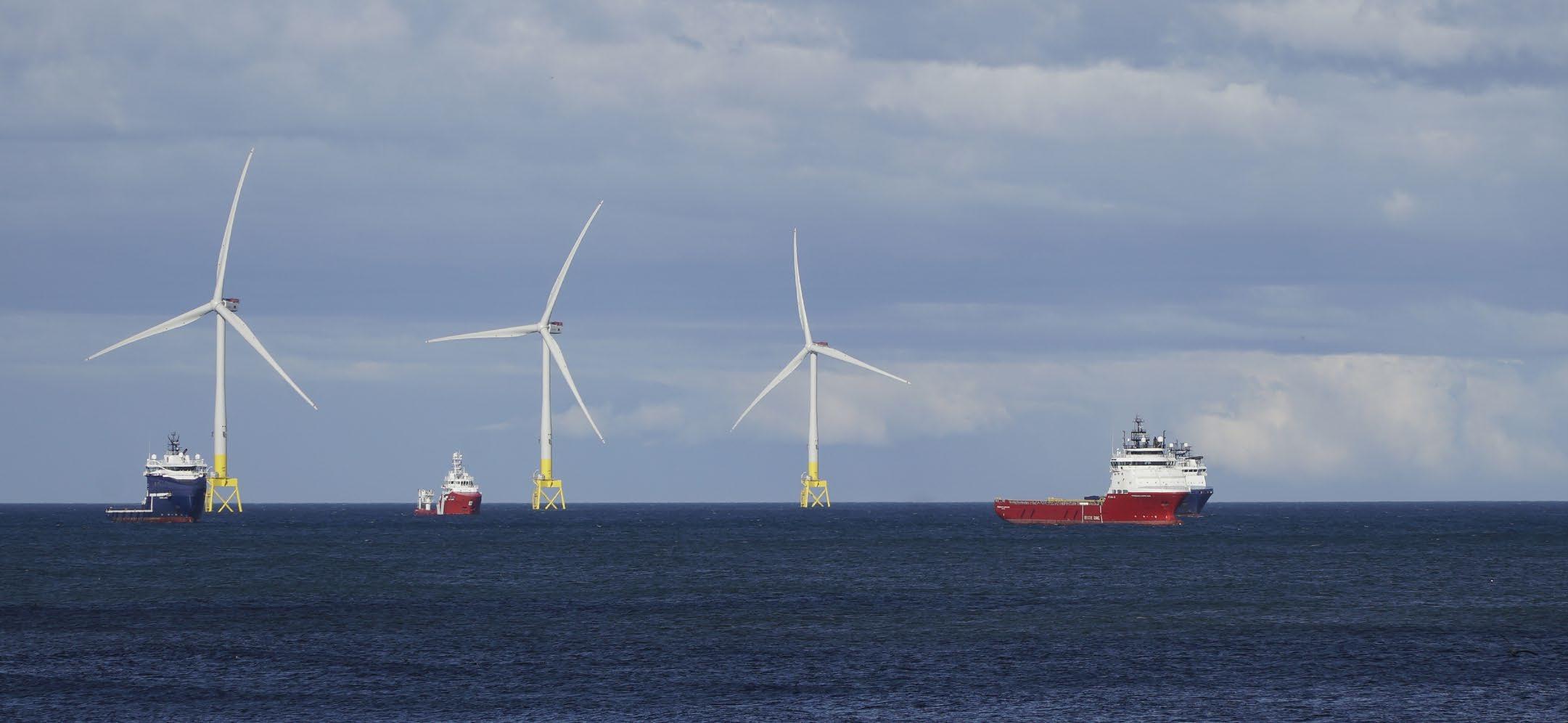
GLOBAL news
renewable news SPONSORED BY 13
UK

Offshore Wind Farm Atlantic Shores Ocean Winds
$1.8bn
Development of an 882MW offshore wind farm, located approximately 22.5km from Caithness in the Moray Firth of eastern Scotland. The site will comprise of 60 x SG 14-222 DD units. Boskalis recently secured a €50-150 million multidisciplinary contract, for the transport and installation of the monopiles and two substations with their respective transition pieces.
Energy projects and business intelligence in the energy sector
The EIC delivers high-value market intelligence through its online energy project database, and via a global network of staff to provide qualified regional insight. Along with practical assistance and facilitation services, the EIC’s access to information keeps members one step ahead of the competition in a demanding global marketplace.

renewable PROJECTS RENEWABLE PROJECTS
The EIC is the leading Trade Association providing dedicated services to help members understand, identify and pursue business opportunities globally.
It is renowned for excellence in the provision of services that unlock opportunities for its members, helping the supply chain to win business across the globe.
The EIC provides one of the most comprehensive sources of energy projects and business intelligence in the energy sector today.
Australia
Floating Offshore Wind Farm Eastern Rise BlueFloat Energy $3bn
BlueFloat Energy has announced plans to construct a 1,700MW floating offshore wind farm, located within the offshore wind zone in the Pacific Ocean, off the Hunter region of New South Wales.
The development of the wind farm is anticipated to take around seven years.
USA
Offshore Wind Farm Revolution Wind 2 Ørsted & Eversource Energy
$2.5bn
Ørsted and Eversource Energy have plans to build the 884MW Revolution 2 wind farm, off the coast of Rhode Island and Massachusetts. The proposal was announced as part of Rhode Island’s second offshore wind solicitation, and was the sole bidder in the auction.
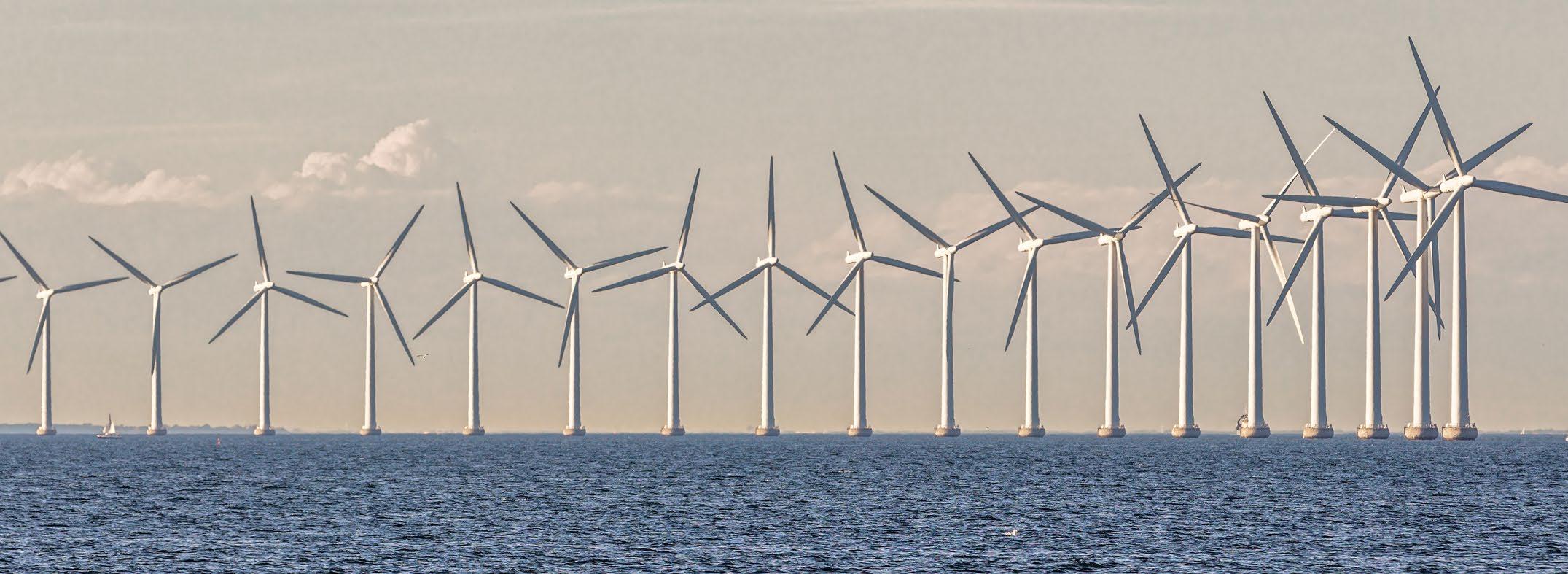
Brazil
Atobá Offshore Wind Farm Equinor
$7.5bn
The 2.49GW proposed wind farm, off the coast of Rio Grande do Sol, is one of the seven wind farms that falls under Equinor and Petrobras’ recently signed Letter of Intent (LoI). The two companies will work together to assess the proposals, with the LoI being effective until 2028.
2 3
renewable projects SPONSORED BY
www.eicdatastream.the-eic.com 1 4 14 www.ogv.energy - Issue 3
Portugal
Floating Offshore Wind Farm Botafogo
IberBlue Wind
$37.5m
Proposal of a 990MW floating offshore wind farm located off the coast of Figueira da Foz, featuring 55 x 18MW wind turbines. The wind farm is planned to be in the 4GW Figuera da Foz area, one of the five designated drafting areas in Portugal’s first offshore wind auction in 2023 totalling 10GW. However, Copenhagen Infrastructure Partners has also proposed a 2GW wind farm in the same site.
Jordan
Kulanak Hydro Power Plant
Government of Kyrgyzstan $117m

Construction of a 100MW hydroelectric power plant on the Naryn River, village of Kulanak in the Naryn Region. The Eurasian Development Bank (EDB) and Naryn Production Enterprise have reached an agreement to fund its construction and operation of the project. The Russian-Kyrgyz Development Fund (RKDF) also intends to contribute to the project’s financing.
South Korea
5
6
Offshore Wind Farm Wando (Geumil-do) Korea South-East Power Co (KOEN)
$503bn
A 600MW offshore wind farm off the coast of Wando county, Jeonnam / South Jeolla Province, South Korea. The project will first build phase I totalling 200MW, and for this phase, Vestas has been chosen as the preferred turbine supplier. The phase will feature 40 x V236-15.0MW wind turbines.
Canada
Williston Basin
Geothermal Power Plant DEEP Earth Energy Production Corporation

$200m
A 25MW geothermal plant in Williston Basin, Saskatchewan. The project will source energy from the geothermal reservoir in the Deadwood Formation and will have ten horizontal wells (6 producers and 4 injections) that will be drilled to a vertical depth of approximately 3.5km and a horizontal length of approximately 3km. The developer has reportedly finalised the EPC contractor hiring, with these works to commence in Q3 2023.
Tonga
Tongatapu Wave Power Project Seabased Industry AB $100m
Development of a 10MW wave power park in Tongatapu, in the South Pacific island country of Tonga. Seabased Industry AB, the government of the Kingdom of Tonga and SIDS DOCK, have signed a Memorandum of Understanding for the project. The project will be developed in two phases, with phase I and II featuring 2MW and 8MW, respectively.
Scotland
SwimmerTurbine
Flex Marine Power $1m
Flex Marine Power has secured a little over €1 million (£968,000) that will be used for the development of a lowercost tidal turbine for coastal power generation within a microgrid, which will be tested with community partners on the island of Islay.
Indonesia
Cirata Reservoir Floating Solar Plant PT Pembangkit Jawa-Bali & Masdar $192m
Development of a 192MW floating PV plant on the Cirata Reservoir in West Java province: reportedly the world’s largest floating solar project. Sungrow FPV has received a contract to supply the floating equipment, with the systems’ delivery to commence in Q1 2023. The project will install 700,000 floats and will also include a 150kV high voltage transmission line and a 150kV power substation.
South Africa
Onshore Wind Farm
Koruson 1 Complex
EDF Renewables $750m
An onshore wind complex comprising of three 140MW wind farms: Phezukomoya, San Kraal and Coleskop. The complex will be in the vicinity of Middelburg, in the Umsombomvu Local Municipality, and comprise of 78 turbines in total. The Coleskop site recently secured financial close, and construction of all three wind farms are now underway.

1 5 3 8 2 9 6 10 11 12 7 4
8
9
12
11
10
renewable PROJECTS PROJECTS MAP SPONSORED BY 15
7
OFFSHORE WIND THEMES TO WATCH IN 2023
By Bahzad Ayoub, Senior Analyst Offshore Wind, Westwood Global Energy Group

The offshore wind sector witnessed another year of high growth despite global financial uncertainties. Although 2022 did not match 2021’s record of over 19.5GW of online capacity, which was mainly driven by the expiration of national feed-in-tariffs in Mainland China (MC), 2022 witnessed the second highest amount of global online capacity with almost 8.5GW. Final investment decisions (FIDs) were taken on over 11.5GW of projects, making it the fourth highest year for FIDs.

2023 capacity additions are forecast to be 55% higher than 2022 levels, keeping the offshore wind sector busy. This continued growth is expected to take place in a year where the sector will also need to deal with several issues to keep up the momentum. Some of the key themes that Westwood expects to see this year include the continued awarding of lease areas as well as the launch of auctions in new markets, investment in newbuild vessels, development uncertainties, the fallout of losses faced by turbine OEMs, the emergence of Chinese EPC supply chain companies entering markets outside of MC and the integration of offshore wind with other forms of energy. We explore these further below.
THE FUTURE OF RENEWABLE ENERGY
Flotation Energy and Vårgrønn are leading the way in the development of offshore wind projects. Determined to support the global movement to Net Zero and sustainable energy consumption, our core strengths lie in finding and developing sites for floating projects in deeper waters globally. Together we have harnessed our expertise to deliver reliable oil and gas electrification and decarbonisation projects that will pioneer the future of renewable energy.
AUCTION RESULTS AND NEW AUCTIONS TO BE LAUNCHED
A total of 54.9GW of offshore wind leases were awarded in 2022. The ScotWind lease round accounts for most of this capacity, with over 24.8GW of project capacity being awarded in the initial round and a further 2.8GW in the clearing round. Several offshore wind lease rounds are scheduled to be launched and potentially conclude in 2023. These include the 4GW Celtic Sea floating wind auction in the UK, the 500MW A06 (Floating Mediterranean) auction in France and the Central Atlantic, and the Gulf of Mexico and Oregon auctions in the US.

Offshore wind auctions are also planned to take place for the first time in new markets that are aiming to develop projects. Up to 10GW of floating wind projects are planned to be auctioned in Portugal, 4GW are planned to be auctioned offshore Tamil Nadu State in India and Lithuania is also planning to launch its first lease auction for a 700MW wind farm.
Alongside these lease auction rounds being launched, the results of auctions that are currently taking place are also expected to be revealed in 2023. The results of 6.2GW INTOG Leasing round in the UK is scheduled to be announced this year. Poland is planning to conclude its auction for up to 11GW of lease areas and France is also expected to announce the winners of the 250MW Brittany Floating Wind and the 1GW Normandy fixed bottom tenders. Elsewhere in Taiwan, the floating wind tender, which was scheduled to be released in 4Q 2022, was delayed until 1Q 2023, although Westwood predicts it remains scheduled be awarded in 2023.


Some recent lease auctions have witnessed the implementation of qualitative criteria when it comes to selecting the winning bidders. The Hollandse Kust West Site VI tender in the Netherlands included a criterion for bidders to demonstrate how their proposal would contribute to the ecology of the North Sea. Qualitative measures are being implemented in future auction rounds and their importance is expected to increase. The Utsira Nord auction in Norway highlights this shift as the lease areas will be allocated to bidders on the bases of qualitative criteria such as proposed projects contribution to innovation and technology development.
INVESTMENT IN NEWBUILD VESSELS
Offshore wind production targets that have been set by various countries, means there will be a lot more offshore construction activity taking place globally from the mid-2020’s. In turn this will translate to increasing demand for construction vessels in the offshore wind sector. Separately, the Jones Act creates a situation in the US whereby newbuild vessels will be required for the US offshore wind market, as under the Act only US-built vessels can be used in US waters. Vessel suppliers have identified this demand and several orders have been placed for newbuilds in 2022.
Starting with wind turbine installation vessels (WTIVs), Cadeler has placed an order for two F-Class WTIVs. Separately, a consortium of ONP Management & Renewable Resources has ordered a Jones Act-compliant WTIV, while Bleutec Industries placed an order for a Jones Act-compliant hybrid vessel. The Binary Marine Installation Solution (BMIS) will consist of two construction vessels –one for foundation installation and one for wind turbine installation. Moving onto heavy lift vessels (HLVs), Vallianz placed an order for a turbine foundation transport vessel. Finally, in terms of newbuild cable lay vessels, two orders have been placed and these have come from Prysmian and Cecon Contracting respectively.
Outside of these 2022 firm orders, letters of intent/option agreements have been signed for several offshore wind construction vessels. There are currently five WTIVs under these agreements and three of these have been signed by Havfram, whilst the remaining two have been signed by Van Oord and Subsea 7 respectively. The transition of these agreements to firm orders will be dependent on how quickly offshore wind projects progress globally, as this will be the key determining factor on when a vessel demand crunch will occur.
WIND
1 2
16 www.ogv.energy - Issue 3 WIND ENERGY
SPONSORED BY
DEVELOPMENT UNCERTAINTIES

2022 was a year in which the offshore wind sector faced several risks, which have the potential to impact decisions of developers investing in their forward-looking pipeline. Factors such as price volatility, cost inflation, political unpredictability and supply chain bottlenecks will continue to make commercial decisions increasingly difficult and uncertain in 2023.
Cost inflation from raw materials and rising energy prices have resulted in a reduction of the financial viability of projects. As a result of this, developers may seek to renegotiate financing agreements, potentially resulting in delays in the development of projects or even causing them to cancel projects.
Some developers of offshore wind projects in the US have already expressed their concerns. In December 2022, Avangrid filed a motion with the Massachusetts Department of Public Utilities (DPU) to dismiss the review of power purchase agreements (PPAs) issued to its 1.2GW Commonwealth Wind offshore windfarm in 2019. Avangrid has declared that it wants to submit a revised bid that reflects economic changes since late 2021. Mayflower Wind Energy LLC, a joint venture between Shell New Energies US LLC and Ocean Winds has also expressed worries regarding the financing challenges for its project in Massachusetts. Despite these worries, the PPAs for both projects have been approved by the Massachusetts DPU.
Elsewhere in Taiwan, Orsted cited “high inflation and increasing interest rates”, together with limitations set by current regulation, is making projects “uninvestable at this stage” – the developer declined to bid in Taiwan’s Round 3.1 lease auction.

Reactive political policies with regards to high inflation have also created uncertainties for project developers. In the UK, for example, a windfall tax with a temporary levy of 45% on profits has been introduced for electricity generators and this includes offshore wind farms. Although this only applies to wind farms that are not supported by the Contracts for Difference (CfD) subsidy mechanism, it still impacts project developers who operate these wind farms, and it will have them questioning their future investments.
FALLOUT OF LOSSES FACED BY TURBINE OEMS
International turbine manufacturers have had a difficult 2022, with Vestas, Siemens Gamesa and GE reporting financial losses. Vestas reported a loss of EUR1.031 billion (approximately US$1.068 billion) in the first nine months of 2022. GE has announced losses of US$1.786 billion in the first nine months of 2022 from its renewable energy division, whilst Siemens Gamesa reported an annual loss of EUR940 million (approximately US$975 million) in its FY2022 results. Siemens Gamesa also announced that it is planning a 10% reduction of its workforce by FY2025 as part of its long-term cost cutting strategy.
Although most of these losses can be attributed to the onshore wind side of these companies, they will have knock-on effects on their offshore wind segments. Outside of the aforementioned issues that each of these OEMs are facing, the offshore wind sector is grappling with several challenges, such as rising material costs and increased energy prices. As a result, turbine OEMs are facing significant losses as the pricing for the turbines have already been agreed upon, meaning that any price rises or additional costs incurred upon delivery, are absorbed by the OEM.
The likely fallout of these losses will be increased pricing from the turbine OEMs, which in turn will impact project developers, potentially leading to delays in projects as the developers may have to prioritise their project investments. As Vestas, GE and Siemens Gamesa are currently the only OEMs that supply the market outside of MC, and these companies are facing financial difficulties, there is now ample opportunity for new players to enter the field.
CHINESE EPC SUPPLY CHAIN COMPANIES ENTERING NEW MARKETS
After experiencing huge capacity growth in 2021 adding 16.4GW, driven by the termination of central government subsidies, 2022 and 2023 installed capacity is still forecast to remain higher than the average 2-3GW levels of 2019-2020. Mainland Chinese EPC contractors have begun making inroads outside of MC and this is expected to increase. Although a small number of Chinese supply chain companies have managed to secure contracts, they are aiming to increase their market share by investing in the development of factories in international markets. Ming Yang Smart Energy and Dajin Heavy Industry are examples of companies that are pursing markets outside of MC, with both companies signing contracts whilst developing and pursing plans to establish local manufacturing centres.
Ming Yang’s turbines have been operating offshore Italy at the Taranto wind farm since April 2022. The turbine OEM has also been awarded a contract to supply a turbine at the Nyuzen wind farm in Japan and it has also been selected to supply four turbines for the TwinHub Demonstrator floating wind project, offshore the UK. In terms of operating outside of MC, Ming Yang has selected the UK as its first new market. The OEM listed on the London Stock Exchange in July 2022 and has also signed a Memorandum of Understanding (MoU) with the UK Department for International Trade (DIT), focusing on MingYang investing in a blade manufacturing factory, a service centre and potentially a turbine assembly factory in the UK.
Dajin Heavy Industry has had a banner year outside of MC. The fabricator has been awarded a contract to supply turbine towers and turbine foundations at Moray West in the UK. It has also been awarded a contract to supply turbine foundations at the Noirmoutier project, offshore France. Dajin also announced that it is planning to open a European turbine foundation manufacturing factory capable of manufacturing XXXL monopile turbine foundations, jacket turbine foundations and floating turbine foundations.
INTEGRATION OF OFFSHORE WIND WITH OTHER FORMS OF ENERGY
Hydrogen production, electrification of oil and gas (O&G) platforms and the joint development of offshore wind projects with other renewables are some areas in which offshore wind projects are starting to combine with other forms of energy.
The world’s first O&G electrification project via offshore wind, Hywind Tampen, began operating in November 2022 and this is scheduled to be fully commissioned in 2023. Net-zero targets, increasing carbon prices and higher energy costs are driving increased investment in the electrification of O&G assets. The results of the INTOG leasing round in Scotland are scheduled to be announced by the end of March 2023 and this will be a major first step in transforming offshore wind electrification from a demonstration scale concept to commercial scale projects.
The offshore wind sector will also witness an increase in projects being combined with other sources of renewable energy. A recent example of this is Hollandse Kust West Site VII wind farm in the Netherlands. RWE Renewables won the lease rights to this site in November 2022. The project developer is planning to provide surplus electricity to power green hydrogen production on land and to incorporate floating solar panels to allow a more efficient use of ocean space. SolarDuck will build a 5MW floating solar power demonstrator at the site of the wind farm, and this is scheduled to come online in 2026.
The world’s first hydrogen-producing offshore wind turbine project received funding in May 2022. The UK government awarded Vattenfall £9.3 million (US$11.5 million) in innovation funding from the Net Zero Innovation Portfolio Low Carbon Hydrogen Supply 2 fund for the Hydrogen Turbine 1 (HT1) project. An electrolyser will be installed directly onto an existing operational turbine which is currently producing power at the 96.8MW Aberdeen Bay wind farm located offshore Scotland, UK. The turbine will be used to produce hydrogen, and this will then be transported via a pipeline to shore at the Port of Aberdeen.
WIND
3 4 5 6 wind energy SPONSORED BY 17
Hi Claire, Welcome and can you introduce yourself and Scottish Renewables, please?
Of course, I’m Claire Mack, the Chief Executive at Scottish Renewables and Scottish Renewables is the voice of the renewable energy industry here in Scotland. We've been around for about 20-odd years, and represent the industry and work with the supply chain to devise policy positions and to advocate on their behalf to create the best possible environment for us to develop projects.

The offshore renewables industry in Scotland has really been hitting the headlines over the last year or so, can you provide us with an overview of what’s been going on?
Absolutely, as you say the industry has been all over the news and for a really positive reason, which is just the scale of the development opportunity that is available around the coast of Scotland. If we'd been talking just over a year ago, we would have been talking about 11 gigawatts of offshore projects in Scotland, but now what's happened is that we are now sitting with a target of around 28 gigawatts for Scotland, which is huge. A number of these projects are going to be floating projects, so really, we've got one of the largest commercial floating opportunities in the world, right here in Scotland, which is really, really exciting to see a pipeline like that!
Brilliant, and is that level of growth sustainable?
Demand for green electricity is only going to grow. We know that and we've certainly seen a real impetus behind that and the real reason behind it comes from the debate around energy security. So the demand will grow and our pipeline at the moment takes us out too well beyond 2030.
The need then is to balance that development opportunity with the environment, to balance that with supply chain growth and various other elements as well, such as the underlying infrastructure growth. Clearly, grid and networks are hugely important. For the first time we've got a really strong pipeline that is multi-decade long, which is great.
That's something that we've not really ever had as an industry before. Energy policy has tended to be a little bit stuttering in the past. So now, to have this opportunity is really, really brilliant and it gives us something to work towards
beyond what we do in our own country. We've obviously got huge opportunity for export as well, because the rest of the world are going on the same journey as we are.
In addition, we are starting to see the development of other fossil-fuels based economies like China. What they've been doing is building wind and solar at an enormous rate and we have that exciting opportunity to be able to contribute to that from an export position as well, so, yes, I would see growth as sustainable.
Great. You mentioned briefly there about energy policy. Is there a significant energy policy or event that's resulted in this acceleration offshore?
There was already quite a strong impetus, brought around by the Johnson government here in the UK. He was a very firm supporter of the offshore wind sector and also started to lay the foundations for onshore wind to reenter the energy mix through making sure that it was included within the policy framework that we've got in place at the moment. We have started to see a real step change. It started, I guess, with COP. There was a lot of interest in that net zero conversation. It's shifted somewhat over the last couple of years and over the last year or so to be much more focused on energy security and also on economic growth as well.
So I think there's that recognition from the government that actually we can do more than one thing here. We're not just about producing green electrons. You can actually reinvent the energy system here and also recognising that this is a huge industrial opportunity for the UK.
Can you tell us anything about the number of jobs that are sustained in Scotland through the renewable energy industries and how that outlook is?
We've done some work recently at Scottish Renewables with the Fraser of Allander Institute at the University of Strathclyde, which is showing us that we've got 27,000 jobs in the industry today, which is great. We want to see that grow and it will grow because we have that phenomenal pipeline not just of offshore wind, but of onshore wind and the various other technologies as well. So we think that the outlook is certainly for job growth over time.
How do we go about maximising the involvement of Scottish companies in this industry?
We've already got a huge number of companies working within the industry. We've got a very long and wide and deep supply chain, and that helps us to deliver our projects. But one of the ways to really maximise that involvement is for us to understand what we're good at. And there's been a lot of work that's going on with industry, particularly in the offshore space, to have a look at the capacity and the capabilities of the supply chain, because we're looking to grow that, to make sure that we can meet the demand that's going to come from that huge pipeline that I talked about earlier.

So understanding what we're good at and investing in new technology and new processes. We've done a lot of work, again, you know, through deployment where we've learned loads of lessons that we've been able to pull together to maximise our effectiveness and efficiency, but also being able to ensure that we can create better opportunities as well for the supply chain in this country.
Do you think there's more can be done to ensure we're adding value to the supply chain in Scotland?
There is always more that can be done. I think what we need to be mindful of is the supply chain in general are small to mediumsized enterprises, you know, there's a real concentration of those sizes of business in there, and they need help with different things. So I think if you want to ensure greater value add, then its about focusing the efforts of our enterprise agencies, for example, focusing the efforts of our economic growth strategies on those particular bodies of business. Because in order for them to really grow and to invest, we need to be quite clear about how we help them do that. I think using them to collaborate with each other, but also building better engagement between the different tiers of layers of supplier and subcontractor and developer and commissioner of work is really, really important as well to ensure that we can really drive better value through the supply chain.
Brilliant. You mentioned earlier on, Claire, that there's opportunities for Scotland to export some of this knowhow. So, are there specific areas of competence where you believe Scotland can grow and can export those technologies worldwide?
WIND
Claire Mack – CEO of Scottish Renewables
18 www.ogv.energy - Issue 3
Interview by Moray Melhuish – Founder of Annet Consulting, an Offshore Wind and Subsea Specialist
Yes. I think in terms of exporting worldwide as I said, there's a huge opportunity particularly for floating offshore wind. That's one of the key areas of competence that we've got that opportunity to grow here domestically with our domestic projects and then export that across the globe. Its, really important and I think there are some elements that we need to look at.
Finance is absolutely huge, so making sure that we've got finance available for some of these smaller companies as well as the larger companies to be able to get into that export market. We did some research again at Scottish Renewables into the export space - the story there is that you've got quite a narrow base of exporters but a huge reach and that means that you've got brilliant potential for growth if we can use what we've got already in peer to peer networks, for example, to help other companies understand how to access export markets and to get that foot in the door.
High tech, high value is very much the watchwords of what we'll be thinking about in terms of export, you know, and also we've got the advantage of working in the North Sea in some of the most difficult development conditions. Therefore, again, we're going to be gaining expertise, which is going to be useful wherever you want to go in the world.
So, we know that the offshore wind industry is growing brilliantly, and the pipeline is substantial and only getting bigger. Can you give us some insight into some of the other renewable industries and how they're fairing?
Yes, we've come through some pretty tough times as a sector and certainly even in my time at SR. I've been at Scottish Renewables for about six years and our fortunes have changed beyond recognition in that particular period of time because of that step change in government policy.

It's really boosted interest in things like solar for people to be able to self-generate power, businesses in particular. To help them selfgenerate too. Onshore wind, is clearly now back in the energy mix too through the contracts for difference auctions.
But you know whilst it was sitting outside of that particular framework they were working very hard on merchant models, merchant models to market, new merchant routes to market, and private wire type arrangements which have become really, really interesting as well, that kind of firm PPA type market really grew in that period of time.
You've also got hydro, so pump storage hydro, is a really important part of the integration story and needs to be part of that mix. We've been working really hard with the government to help them understand the benefits that pump storage hydro brings, not just as a tool, a systems tool, but also to gain, you know, huge socio-economic benefits in that civil engineering market as well.
Where things aren't so good I guess the outlook is quite poor for smaller scale projects
and that's a real disappointment because particularly through that prism of the cost of living crisis, you know, we know that householders are really, really keen to be able to get help with self-generation, help to understand how to do this for themselves, how to set themselves up at home.
But there is capital expense in there and also, you know, no type of freedom tariff has made it incredibly difficult for householders to be able to really join the renewables revolution.
You mentioned onshore wind briefly there. The UK legislation changed recently, didn't it? Can you take us through that and also how it'll affect Scotland?
There was a policy change which was to enable onshore wind to compete again in the power auctions that are held now annually by government. There's a huge opportunity for onshore wind in Scotland, particularly in Scotland, because our planning system has also been going through a bit of a refresh and it has become very open and positive about the development of onshore wind here in Scotland, which is great because the scale of the resource here is also good in other areas of the country.
Its less easy in other areas of the country and I'd certainly say it is less easy down in England. But one thing that is happening here in Scotland is that we're working with industry and government on an onshore wind sector deal which could see up to 20 gigawatts of onshore wind come out of Scotland, which

is a phenomenal figure and an opportunity for us to look at new pipeline as well as repowering some of our existing sites. This is because of our early movement on renewables here in Scotland, actually coming to the end of their first phase of life and are actually going to be prepared for their next phase of life, which will involve taller turbines, with more efficient technology and really bringing onshore wind back into its next iteration in the energy market.
www.ogv.energy/play




WIND
full interview
watch
wind energy SPONSORED BY OR LISTEN TO THE PODCAST 19
Hi Alan, welcome to podcast, how long have you been in offshore wind?
I've been in offshore wind since about 2001.
I was working in Talisman Energy and I was asked to have a look at this concept that we had been approached about and it grew over the next six or seven years, until we actually built the turbines in the Moray Firth, which were at the time the biggest turbines, furthest from shore, in the deepest water, and the first to go on jackets and the first to go on the continental shelf. And that was how I ended up in the wind business!
Wow, that really is some really pioneering stuff, what observations have you made about how the industry has changed since then?
It's really interesting, it was an idea just coming to fruition. Onshore wind was sort of taking shape, but even then, it was subsidised and meeting lots of resistance. The concept of going offshore was just being talked about and I think as we got into it, they had put two machines off Blyth and some on the harbour and there'd been some work done in the Scandinavian countriesDenmark and Sweden, and that really was it.
We decided that we needed electricity for our oil platform and for various reasons, which are now lost and mired in time, Talisman ultimately decided to sanction, in partnership with SSE, the construction of the two turbines at Beatrice.
Tell us about your projects at Flotation Energy?
Well, Flotation Energy is a follow-on not just from the Beatrice Project, but from Sea Energy, which was the first company we set up and then from the Kincardine project. Flotation Energy was a concept that my colleague said we should pursue in early 2018.
We develop fixed and floating wind projects, depending on what's available and what the opportunities are. We have built and been part of that business model for ten years now since we first started Kincardine.
The idea that this would grow into a major industry and over the next ten or 15 years, the dominance of floating wind would come to pass. There will be more floating wind in this world than there will be fixed wind because there's more deep waters than there are shallow waters.
You mentioned there that you had some investment from TEPCO (Tokyo Electric Power Company). How has that affected the business and its plans?
TEPCO are the largest utility company in Japan and the fourth biggest utility company in the world. We are part of TEPCO Renewables. The team has around 100 people in Japan who specialise in wind. Its largest objective is floating wind because of the nature of Japan, they have no continental shelf and you can very quickly find yourself in 1000m of water and the Pacific. Fixed structures are not going to work there.
Does this mean we will see Flotation Energy setting up in Japan. Or how does it affect your international footprint?
TEPCO are now our parent company and we will be working with them on many global projects, some where they will take the lead, but perhaps what may also happen is that we will be their vanguard in Europe and other parts of the world where we have the experience.

Alan, closer to home we've got some huge plans for floating offshore wind, not least of which is, of course, INTOG. Can you give us an overview of INTOG? What is it? What are its goals? And what's your approach?
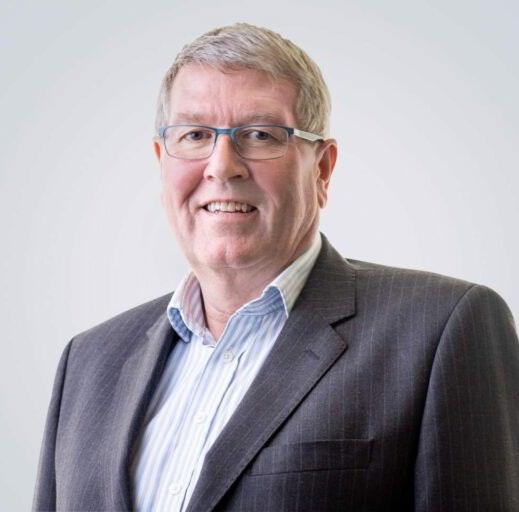
INTOG is a concept that stands for ‘Innovation and Targeted Oil and Gas Decarbonisation’. It's really two programmes in one. One is for those who want to develop a 100-megawatt test and demonstration project, they can get that. We already have one in the Celtic Sea, which was awarded by Crown Estate in England, we got that a couple of years ago.
And then the other piece of it is something that I specialise in and that is the targeted oil and gas decarbonisation. The objective is to do what we did when we built the Beatrice Turbines in 2006/7, which was adjacent to an oil field, and the turbines power the oil field, providing us with energy power and also the life extension project for Beatrice.
What's the timescale for INTOG?
Well, the timeline that we are involved in is very different from most offshore wind farms. We saw the opportunity of the Green Volt Project in 2019. In 2020 we started the process of gathering the necessary data. Last April, we finished all of the data gathering that you need for birds and various other impact assesments. We pre-invested in that and in conjunction with the operator using their vessels and various
things, we managed to gather all the data. The site is also a decommissioned oil field site, so we have all the data from that oil field which was discovered in the seventies. All of those things together have allowed us to put the consent application in, although we haven't yet been awarded the lease for the site we have the consent application in the system, which means that by the end of this year, assuming we win the lease, we will have the consent.
If we have the consent, then with our partner Vårgrønn, we can apply for the CFD (contract for differences) for floating technology next year, which means that by the second half of next year, we can go to FID (final investment decision) and then the project can be online in 2027.
We now see a significant uptick in demand for oil and gas, huge demand from offshore wind and I just wonder how do we square that circle?
How much of a threat is scarcity of resources for delivery of these project?
That is going to be a challenge, there's no doubt about it. But it's something that ultimately is about speed. I mean, I think that we are right up at the front of the wave.
Of the two big projects Flotation Energy has with our partner Vårgrønn in Scotland, one is in the consent process and the other one is in the scoping process. It will be three or four years before virtually any other project can get to that stage. So, we're ahead of the game.
Our two projects, if we can get them across the line, should be delivered in 2027 and 2028. The second one is much bigger at 1400 megawatts and it has a much more difficult connection because it's simply further offshore, near bigger oil fields. So, that's the challenge that we've got to get to. But the whole process of consenting and progressing projects really does need to be simplified.
Is there something specific that you'd like to see improved in that process?
Well, I guess the biggest single bugbear is probably the national grid, which is a system in which there's lots of people with an established interest and lots of things running, but it's a process that was designed 30, 40, 50 years ago for a different world where you wanted to take power from large centralsed coal-fired power stations to large urban areas. It's not designed to pick up remote power distributed around the North Sea and take that to those conurbations, so that's something that has to be addressed.
WIND
Alan McAskill – Chief Technology Officer, Flotation Energy plc
20 www.ogv.energy - Issue 3
Interview by Moray Melhuish – Founder of Annet Consulting, an Offshore Wind and Subsea Specialist
So, Allan, these are massive scale opportunities. You know, there must be some significant employment opportunities available in these projects. With Flotation Energy, can you give us a little bit of an overview of those opportunities?
Of course. We are recruiting and we're bringing people in from a variety of different industries. We bring quite a lot of people from oil and gas. I came from oil and gas and many of my colleagues came from oil and gas. We also bring people in from different aspects and try to work with the big tier-one suppliers, because we won't be manufacturing the equipment, we'll be commissioning them and making sure they understand what we're doing, where we're going to go, what the ideas are to speed up the process and to make it efficient.
Thinking of people at the beginning of their careers. Do you think we are doing enough to get people into our sector, into offshore wind?
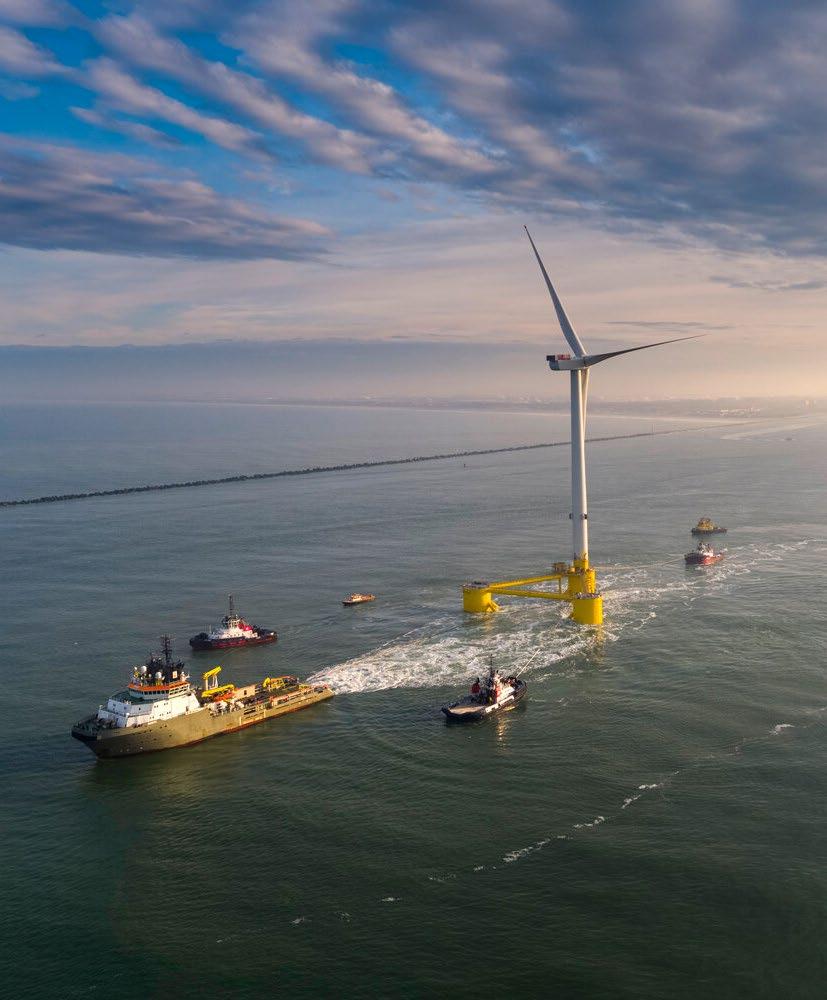
I always try to do what I can. If any young person comes to me and says they'd like some information, I'm usually happy to chat with them. I didn't know about oil and gas when I was a child growing up, I knew a little bit about it. I came into that industry through various things at the university and I have moved around within it and then moved into a different business. So I think the important thing is trying to get people interested in science, technology, engineering, and things like that, which I've always been prepared to work with and to do with people. Last year we took out two groups of students to Kincardine, which allowed them to physically see it. I think when you get a chance to go and do it and see something like that and you see that the top is 191 meters above and you are two meters above the sea then that starts to say "that this is something I am quite interested in".
Brilliant I mean, if the young people out there want to get involved with Flotation Energy, how do they get in?
Well, you can visit our website and apply for any jobs that we have are there. We are actively recruiting and we have a number that we need to recruit this year, a pretty significant number.
Thinking about success for Flotation Energy, how do you define that?

Success for Floatation Energy is to provide opportunities to our parent company into which we can invest capital and deliver a large amount of power. They have an ambitious target and we need to be able to provide them with the opportunities to deliver that target.
So, it's difficult, it's challenging and it's not very far away when you remember the scale of what we're attempting to do.
Alan, the last podcast episode that we recorded was with Phillipe Kavafyn, the executive director at Aker Horizons, and he left this question for you. ‘After the introduction of the Inflation Reduction Act in the USA, which boosted most energy transition technology, what is the very concrete measure which you would expect from Europe to boost your domain of activity?’


Well, it's an interesting question. I read an article in The Economist about the ‘Inflation Reduction Act’, and it says the one thing you need to avoid is basically a competition of build European. Things that are successful are done not because you say it's got to be built in say America, but that's what they're going to do.
But what we do need to do, I think, is make ourselves more competitive, and the way to do that is to speed up the processes and
the time it takes to actually build these things, to get them to a point where you can finance them. So you've got to allow companies to progress forward.
I'm not convinced that the way we're doing it, certainly in the UK, where we're throwing out loads of projects all over the place is the way to go. It's better to get a few projects running and then get some more following on and some more after that, because to bring cost reduction and scale, you've got to do a project and then once you've done a project, you can do another project, but you've got all that knowledge and you can do it more efficiently, more effectively and you probably get better technology because it will have improved. So it's about making it all happen together and I think that's what we need to do.
WIND watch full interview www.ogv.energy/play wind energy SPONSORED BY 21
Chris Willow, Head of Floating Wind Development at RWE Renewables

Hi Chris, can you introduce yourself and RWE, please?
Of course, I’m Chris Willow, head of floating wind development at RWE and RWE is a fairly large international utility, headquartered in Germany and we are in the top ten utilities in Europe. So, a big player, relatively old as well. I think we're just about to celebrate our 125th anniversary, so we’ve been going for a long time.
As you'd expect from a company that's that been involved in Europe for a long time, we have been and continue to be a fairly large consumer of fossil fuels, but we are going through a big transition at the moment. A big corporate transition with a really substantial program of investment into renewables, into hydrogen, such that we've got a corporate ambition to be climate neutral by 2040.
Well, that's fantastic. Can you give us a little bit more of an overview as to some of the projects that are ongoing outside of just floating wind that you mentioned?
Its onshore wind, offshore wind, seabed fixed. My kind of area is floating wind. We're a big solar company and we're looking into opportunities in hydrogen as a kind of a vector for storage, but also for industrial uses as well. I think the big shifts over the last couple of years and this decade has been moving out of the European home markets and into APAC and the US as well.
Great. What can you tell us about RWE’s footprint and investment in the offshore wind industry in general?
RWE has been involved in offshore wind since 2004, or at least that was when our first offshore wind project was completed. There was a smaller scale project, but the first commercial scale project in the UK was Scroby Sands in Gt Yarmouth and so really it's been a journey since then. We started on those small scale projects, around 90 megawatts, almost 20 years ago and now since then building up a portfolio so that we now I think own Pro-rata, a portfolio of about three gigawatts but have been responsible for building out about five gigawatts of offshore wind and we are in the process of accelerating that.
As part of this transition that I was talking about, I think we're looking to have installed about eight gigawatts by 2030. That is a big challenge in itself and floating wind is going to be a part of that.
Eight gigawatts by 2030, that's fully owned?
Yes.
Great. Tell me, why does offshore wind and in particular floating offshore wind matter?
We need to see all types of renewable generation maxed out. You know, now we've seen costs coming down for onshore wind and solar, we just need to see those kinds of technologies maxed out as well. But I think the offshore wind as a general concept does have a kind of special advantage.
I suppose the big one is the ability to just deploy at scale. In our portfolio we've got the Sofia project in the North Sea, which is 1 gigawatt plus scale project. And so, just being able to deploy projects of that scale I think is really important. It just allows governments and countries to boost that portfolio substantially in a single click.
That helps to drive things forward and I think offshore wind also has the advantage of accessing more consistent resources. It’s an important part of allowing us to generate power more consistently and firmly. We've got large cities, large load centres around coastal regions and by building offshore wind farms in those regions, it means that you can plug directly into those load centres. For example, off the US East Coast, big major cities don't necessarily have access to onshore wind to solar systems in the same scale, but they do have large offshore wind resources.
I think floating wind is the next step for the offshore wind sector. So offshore wind seabed fixed really I think we're talking about that it starts to get costly, too costly, or not cost-efficient, deploying in waters with seabed fixed technology in water depths of more than 60, 70 meters.

But there's obviously large load centres, good wind resource in areas that have deeper waters than that. So, what we need to be able to do is use the wind turbine technology, the same technology, but be able to deploy in deeper waters, and so that's where floating wind kicks in.
Fundamentally, it's going to have the same benefits. It's going to be able to deliver large amounts of capacity at scale.
What are some of the priority markets for floating offshore wind in general? Where are these load centres with good wind resource and the deeper seabed’s, which countries and cities are we talking about specifically?
It's quite a list, actually. I mean, I was thinking about this beforehand, and in no particular order, I think the UK is obviously an important market for that. I think we've got large areas in the North Sea that are shallow water and we've got lots of coastal load centers, but actually there is there's a finite amount of seabed fixed that we can deploy in the UK and floating wind is going to unlock more areas and importantly it's going to unlock different areas as well. So around the coast of Scotland in the Celtic Sea.
I think France is another key market. The French government is taking a position of being a floating wind leader. They've already got quite a few pilot-scale projects deployed or being deployed, and they're running auctions now for 250-megawatt projects this year and will be ramping that up as well.
Also in Europe, we've got Norway and Spain looking to get processes either underway or moving forward.
In Asia-Pacific, I think you've got Japan's famously deep waters there. I think they're focusing in the short term on seabed fixed, just to build up their industry experience. But inevitably, if they're going to want to build up significantly more capacity, they're going to have to move into deeper water.
Korea has also made some very strong positions in pushing forward leasing activity there and Korea has got the advantage of an amazing supply chain that's potentially important there as well.
Taiwan and China in Asia as well. So, I mean, China just generally is going to do things in a big way and floating wind is not going to be an exception.
And then finally, you've also got the US. So both East Coast and West Coast and RWE just at the tail end of last year was successful in a big auction for seabed leasing off the coast of California. So we're in the thick of that market as well, so you can see this isn't just a kind of one or two markets.
This is definitely a big global market.
WIND
22 www.ogv.energy - Issue 3
Interview by Moray Melhuish – Founder of Annet Consulting, an Offshore Wind and Subsea Specialist
Yes there's a huge potential there, isn't there! Chris, could you take us through your projects, your floating wind projects, specifically, I guess, in California, as you've just mentioned.
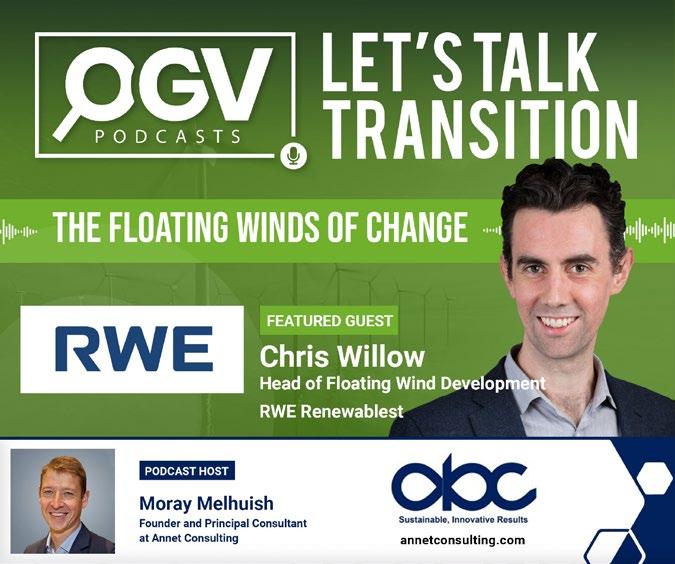

California is the most recent one and I mean all of these projects are typically allocated through an auction process at some stage. So, we've got teams working on lots of projects around the world and each one's difficult and it has its own particular challenges, but it's always great when we do secure something.
I suppose, just taking a step back from that really big California project that we've got, where we've started with our floating journey is with some demonstration projects. So we've got a demonstration project called ‘TetraSpar’ - which you can see just over my shoulder here on my wallpaper. This is just off the coast of Norway.
It's a relatively small turbine. It's called a suspended counterweight concept. So although you can't see much of it just because there's a lot of stuff happening under the water with a keel suspended underneath it to give it stability. And so we're actually just celebrating our first year of generation with that.
We have also got that finally commissioned and up and running in December last year. So learning lots from that as well.


Elsewhere, we've got the ‘DemoSATH’ project, which is a concrete concept that's being deployed off the north coast of Spain in the


Atlantic as well and so that's a very different type of design with all sorts of different design challenges and benefits as well.
That one should be installed, or connected. It's already built-in, it's sitting alongside the key and so we should be towing it out and hooking it up sometime in Q1, or Q2 this year as well. So looking forward to getting that done.
And then I mean, elsewhere, as I said, we've got this California project. So I think it's about 1.2 gigawatts. We participated in a seabed lease auction where other industry players also competed for different sites. I think that was about six sites allocated at which we secured one. The big challenge about California is that the water depths go pretty deep pretty quickly.
The ‘TetraSpar’ here is in water depths of about 200 meters, in California our site has got a water depth of 700 meters or so. So, you know, new technology challenges, I mean, you also famously get earthquakes along the Pacific coast around there. So these are some of the technical challenges that we have to think about.
I think what's been good is over the last year, we've been working very hard understanding those challenges and being able to compete competitively for those bids and think about it. Importantly, that California project is probably not going to be deployed until the beginning of the 2030s, so we've got some time to work through those. In between that we're looking to find other kinds of stepping stone projects that will allow us to build up our experience, and just knuckle through those technical challenges.
WIND watch full interview www.ogv.energy/play wind energy SPONSORED BY OR LISTEN TO THE PODCAST 23
UPGRADING OUR PORTS IS ESSENTIAL TO KICKSTART UK FLOATING OFFSHORE WIND INDUSTRY
By Laurie Heyworth, Senior Policy Analyst at RenewableUK
Anew report by the Floating Wind Offshore Wind Taskforce says up to 11 ports around the UK will need to be transformed as fast as possible into new industrial hubs to enable the roll-out of floating offshore wind at scale.
The report contains a series of recommendations which could see 34 gigawatts (GW) of floating wind installed in UK waters by 2040 if the Government takes swift and decisive action. At present Ministers have set a target of 5GW by 2030.
The Taskforce includes the UK, Scottish and Welsh Governments, the Northern Ireland Executive, major offshore wind and port developers, The Crown Estate, Crown Estate Scotland, RenewableUK, Scottish Renewables, the Offshore Renewable Energy Catapult and other key stakeholders.
The UK is well positioned to become a global leader in cutting-edge floating wind technology, with the biggest project pipeline in the world of 37GW (one-fifth of the global pipeline) and the potential to create tens of thousands of new jobs and attract billions in private investment. Floating wind farms can be built in deeper waters, further from the coast, where wind speeds are even higher. The report highlights the fact that this technology will play a key role in decarbonisation and that it is essential for the UK meets its energy security and net zero targets.
To enable the UK to scale up, the report recommends developing ports as soon as possible by investing £4 billion to ensure they are ready for mass floating wind deployment by the end of this decade. Port upgrades are needed to enable turbines with hub heights taller than 150 metres and their giant floating bases to be manufactured and assembled in coastal locations. The initial focus will be on Scottish ports and the Celtic Sea (Wales and the south west of England) where floating projects are currently being planned.
Initially, a minimum of three to five ports will be needed in Scotland to install turbines onto the floating bases, with a further two ports needed to service the Celtic Sea sector. Additionally, at least four other UK ports will need to be revitalised for manufacturing massive steel and concrete components for floating foundations. More ships and bigger cranes will also be required in the
construction process, creating further industrial opportunities - particularly as there is strong international competition for these among both floating and fixed-foundation offshore wind developers.
The report notes that implementing the recommendations required to reach 34GW of floating wind by 2040 will generate £26.6 billion in additional GVA (total economic activity) in the UK, which in today’s value is about £18bn. It calculates that every £1 invested in UK port facilities would generate up to £4.30 of added value to our economy, and by 2040, the floating offshore wind industry will support 45,000 jobs across the UK.

RenewableUK’s Emerging Technologies Policy Analyst Laurie Heyworth, who worked on the report with engineering consultants Royal HaskoningDHV, said: “Getting onto the front foot to make the most of our enormous floating wind resource is essential to boost Britain’s energy security and deliver net zero as fast as possible. At the moment there are no port facilities in this country which are fit for the mass deployment of floating wind, so we need to start revitalising them now as new industrial hubs, so that we’re ready for this new sector to take off at scale by 2030. The timeline is tight and we will only be able to deliver on our ambition if we take action promptly and decisively.
“The UK has the largest pipeline of floating wind projects in the world. We’re determined to ensure that we maximise the benefits of this innovative industry by capturing significant market share not only in this country but also by exporting our technology and expertise globally. Four-fifths of the world’s potential offshore wind resources is in deeper waters, so floating wind is a key technology which industry and Government must ramp up now, so that we can maintain our global lead in the decades ahead”.
Nicola Clay, Head of New Ventures at The Crown Estate said: “Floating offshore wind is an exciting new frontier in our transition to a more sustainable future, and it’s great to see this report recognise the potential of the Celtic Sea and the hard work we and others are doing to bring this opportunity to market as quickly as possible.
“There is a huge opportunity for the UK to show international leadership in in the race to deploy this new technology at scale, however it is clear from our own dialogue with developers and
ports that this must go hand in hand with the rapid establishment of a new supply chain and upgrading ports. This will require collaboration, confidence and investment by all involved if the UK is to build the foundations for this industry to truly thrive and realise the full range of benefits on offer.”
Colin Maciver, Head of Offshore Wind Development for Crown Estate Scotland, said: “Joint working between ports, industry and governmental bodies, is essential to unlock the full potential of offshore wind.

“The ScotWind leasing round, involving 20 projects and a total of 27.6GW of clean energy, will need a number of upgraded port and harbour facilities to support projects with the potential to help cement the UK’s position as a world leader in floating offshore energy.
"Ensuring these ambitions are fully realised presents a considerable challenge – this report provides a timely and critical contribution to inform how ports develop in the most effective way”.
Emma Harrick, Head of Energy Transition and Supply Chain at Scottish Renewables, said: “Time is of the essence and it is vital that The Scottish and UK Governments invest in Scotland’s ports to build the essential infrastructure we need to kickstart the floating offshore wind industry.
“The 14 floating wind projects announced as part of the ScotWind Leasing round mean Scotland has the most seabed dedicated to develop commercial floating wind anywhere in the world. This gives us a once in a lifetime opportunity to create a major new sector to drive the UK economy and Scotland’s ports are essential for the expansion of this emerging technology.
“The two Green Freeports in Scotland, Cromarty Firth and Forth Green Freeport, announced earlier this year, will help Scotland compete on the international stage as floating offshore wind grows to become the mainstay of electricity generation in the UK - but we urgently need further investment in other ports across Scotland.
“This will ensure we can meet our net-zero targets and deliver the energy security needed to allow the Scottish economy and local communities across the country to benefit from the fresh economic investment and regeneration opportunities which a home-grown clean energy supply brings.”
The new report “Industry Roadmap 2040: Building UK Port Infrastructure to Unlock the Floating Wind Opportunity” is sponsored by RenewableUK, Scottish Renewables, The Crown Estate and Crown Estate Scotland.
WIND
Laurie Heyworth
24 www.ogv.energy - Issue 3
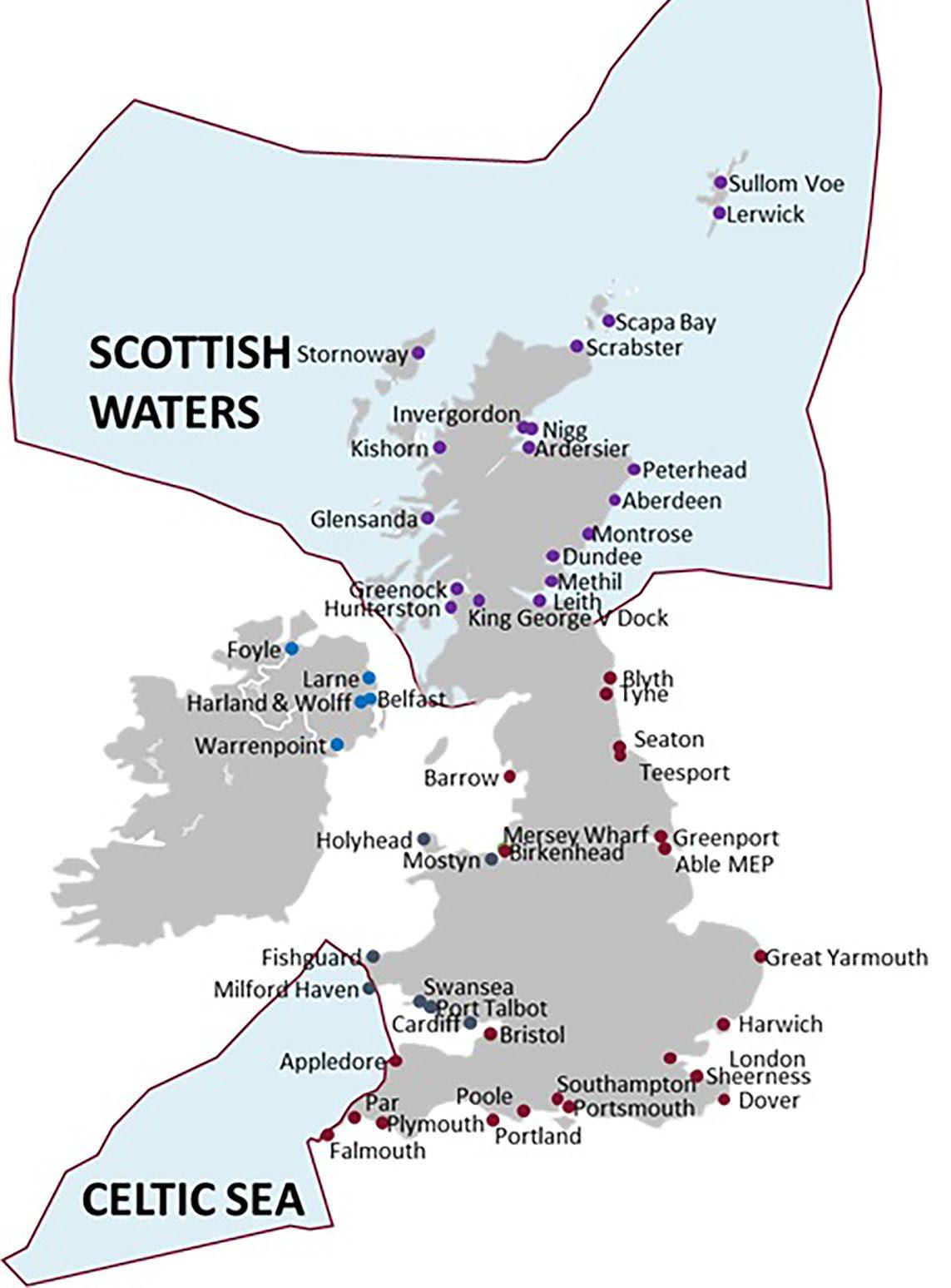



WIND wind energy SPONSORED BY 25
By Jessica McGlynn, PhD Senior Technical Consultant, Leyton

HYDROGEN & CCS
In recent years, the drive for sustainable technologies has been fuelled by efforts to de-carbonise industries through advancements in energy storage, hydrogen production and carbon capture, to name a few, proving to be pivotal in achieving a net zero economy.
Hydrogen in particular has been deemed as the most promising alternative to fossil fuel sources, and has a vast array of uses in sectors ranging from transport to heating. The UK Government has committed to a hydrogen strategy, which will support innovation in each segment of the hydrogen value chain: production, conversion, storage and transport. However, at present, there remains several key areas of uncertainty surrounding each of the above, with significant research required to ensure the safe, efficient and cost effective integration
–INNOVATIVE ROUTES TO A SUSTAINABLE FUTURE HYDROGEN MOU
SIGNED BETWEEN SCOTLAND AND SINGAPORE
Collaboration between Scotland and Singapore in the hydrogen sector is to be strengthened after a Memorandum of Understanding (MoU) was signed between the respective associations of each country.

The Scottish Hydrogen and Fuel Cell Association (SHFCA) and their Singaporean counterparts, the Hydrogen and Fuel Cell Association of Singapore (HFCAS), signed the MoU that will see the organisations work together to promote mutually beneficial hydrogen and fuel cell technology and industry exchange and development.
of hydrogen in current infrastructures. However, the production of hydrogen itself is an active area of research and development. Hydrogen itself can be produced in several ways, resulting in grey, blue and green hydrogen.
Grey: The majority of hydrogen production is currently grey, whereby hydrogen is produced via the steam reforming of natural gas. However, the carbon containing compounds are emitted as greenhouse gases. In this case, the production of hydrogen itself is therefore a major contributor to greenhouse gas emissions, thus in order for hydrogen to be truly ‘green’, it must be produced from renewable resources.
Blue: Known as ‘low carbon’ hydrogen, this form is produced via the steam reforming of natural gas, during which both hydrogen and carbon containing compounds are formed. The carbon materials are then captured and stored for future use via innovative technologies, thus limiting the overall emissions of the process.

Green: This form of hydrogen is carbon free, and involves the splitting of water into its constituent elements: hydrogen and oxygen; using electricity generated from renewable sources. Electrolytic water splitting provides a clean and efficient route to sustainably producing hydrogen. However, there are various challenges currently faced in the industry which require extensive research efforts in
The agreement was announced today (Friday, 17 February) at a MoU Ceremony in Singapore attended by Scottish Government Business Minister Ivan McKee, who is in South-East Asia on a week-long visit to further enhance trade and investment links between Scotland and the region.
Mr McKee said: “I am looking forward to engaging closely with the Hydrogen Fuel Cell Association of Singapore (HFCAS) to increase awareness of Scotland’s strengths in hydrogen production & supply.
“The signing of this MoU between HFCAS and Scottish Hydrogen and Fuel Cell Association is an important milestone as we continue to strive towards reaching our net-zero commitments.”
Established in 2004, SHFCA promotes and develops expertise in fuel cells and hydrogen technologies.
SHFCA has more than 180 members from across industry, academia and the public sector, reflecting the increasing role for hydrogen and fuel cell technologies to enable the deployment of renewables and low carbon technologies in the net zero energy system.
Nigel Holmes, CEO of SHFCA said: “This Memorandum of Understanding between the Hydrogen & Fuel Cell Association of Singapore and the Scottish Hydrogen & Fuel Cell Association will build links that identify
order to overcome. Most commonly, ensuring the efficiency and cost effectiveness of the electrolyser itself in comparison to current stateof-the-art fossil fuel based systems remains an active area of research.
Further to the production of hydrogen, the integration of the high purity, yet explosive gas, into existing infrastructures requires substantial R&D efforts in order to push the boundaries of innovation and advance the overall field to ensure a global hydrogen economy. Leyton offer support in the form of R&D tax relief incentives to help companies achieve their ambitious goals, with the aim of accelerating progress in the renewables sector. To date, Leyton have helped several businesses in the biofuel, oil and gas, and offshore wind industries, amongst various others, gain funding which they can they re-invest in future projects.
Hydrogen is considerably lighter than air (density is 0.090 kg/m3 and 1.22 kg/m3 respectively). As a result, there is a strong tendency for hydrogen to move upwards in case of jet releases at some distance from the point of release where the momentum of the release has decayed. This is very positive for installations in the open, but inside buildings the gas would accumulate against the roof of the building. To avoid accumulation of flammable hydrogen-air mixtures inside buildings, the ventilation is important considering possible release locations, inlet and outlet and effect of larger obstructions.
and develop trade and innovation opportunities between our members.
“This can help us to develop and share best practice in the deployment and safe use of low carbon hydrogen technologies which will be critical for delivering net zero targets in both Scotland and Singapore.”
HFCAS supports the push for hydrogen and fuel cell development and deployment in Singapore. Since its formation in 2019, HFCAS has promoted the use of hydrogen and fuel cells to help in Singapore’s decarbonisation efforts and move towards a greener energy mix for power generation, mobility and industrial applications.
Jan Robertson, Director of Global Trade at SDI said: “Singapore is a market of growing importance to Scottish exporters, offering a gateway to the wider South-East Asia region."
26 www.ogv.energy - Issue 3
HYDROGEN & CCS
Jessica McGlynn
By Gavin Duncan, R&D Manager, Online Electronics / Andy Marwood, Managing Director, Online Electronics
HYDROGEN READY PIPELINE INSTRUMENTATION
Online Electronics, an IK Group company, has over 25 years’ experience in the design and manufacture of pipeline pig locating and signaling equipment and advanced pipeline datalogging and testing systems. This article explains how Online has developed products in readiness for the needs of the anticipated hydrogen pipeline market.

The Opportunity
In the transition to a net-zero emission energy system, hydrogen will play a major role. Large-scale hydrogen consumption will require a well-developed hydrogen transport infrastructure. One of the largest proposed gas transport infrastructures in the world is the European Hydrogen Backbone pipelines connecting hydrogen supply and demand from the north to south and west to east Europe. The network will gradually emerge from the mid-2020s onwards. This will lead to an initial 6,800km pipeline network by 2030. The infrastructure further expands by 2035 and stretches into all directions by 2040 with a length of almost 23,000km. Such a dedicated European Hydrogen Backbone requires an estimated total investment of €27-64 billion based on using 75% of converted or repurposed natural gas pipelines connected by 25% new pipeline stretches. This is fantastic opportunity for proven technology designed and certified for Hydrogen applications in addition to countless others worldwide.
The Challenges
However, the properties of hydrogen present some significant challenges. Hydrogen is lighter than air, highly flammable, easily ignited, heats up when reduced in pressure, does not support breathing and is one of the most difficult gases to prevent from leaking. In its purest state, it presents some unique corrosion mechanisms and when combined with even small impurities (ppm), the corrosion concerns can multiply.
Although auto-ignition of leaks and atmospheric vents is always a possibility with any flammable gas, hydrogen is especially prone to this phenomenon.
This is due to hydrogen’s low ignition energy and the fact that, unlike most gases, hydrogen increases in temperature when it expands from a higher to a lower pressure. This tendency towards auto-ignition of leaks and atmospheric vents, combined with the difficulty in seeing the flame makes small leaks a serious potential personnel injury risk.
This can move the needle in the case of any risk assessment mitigation and as such further consideration is required.
Operation & Maintenance
Hydrogen pipelines are likely to be cleaned and maintained using various types of pigs; wire, foam, scraper, dewatering, line-sized and oversised. It is envisaged they will enter the pipeline via conventional pig launchers and be propelled by hydrogen (or water/dry air/ nitrogen in the case of construction & precommissioning activities.)
A pig receiver is used to allow safe receipt of the pigs once they have travelled through the pipeline. Like the pig launcher, the pig receiver is typically isolated when not in use. When in use, a series of valves allow the flow to be manipulated such that the pig can be received, the pig receiver isolated, safely depressurised thus allowing the quick opening closure to be operated and the pig recovered.
Both the pig launcher and pig receiver typically use two pig signallers (either side of the full-bore pipeline valve) to ensure that the pig has passed the valve allowing its safe operation.

Solution
Presently, most gas pipeline pig signallers are intrusive and are installed during the construction phase. They require either a flanged connection or a welded connection. Maintenance theoretically can be performed if the intrusive signaller is suitable for use with a “hot tap tool” or if the signaller itself has an isolation valve. Typically, all intrusive pig signaller manuals will require change of seals, operating fittings such as springs, magnets etc every two years. In practice, the intrusive pig signallers are rarely maintained as this requires a 2” or small valve to be operated, which is retaining the pressure envelope and/or because the
“jacking bracket” used to remove the intrusive signaller internals has to be operated at height for any trenched/buried pipeline. The entire process consists of several risks, which whilst theoretically mitigable, the impact of failure is either loss of containment, harm to personnel or harm to the environment/facilities.
In addition to this, there is the usual risk with any fitting or instrument containing seals in pressurised service and of course the risk associated with corrosion.
In simple terms, non-intrusive signallers do not require a hole in the pipeline. In that one sentence the risks of a loss of containment and subsequent risk of harm are eliminated. Furthermore, the risk of the following is removed:
• Leaks from the pig signaller itself (which is typically mechanically connected into the pipeline)
• Gas leaks during maintenance and operations (including pre-commissioning and decommissioning)
• Large production carbon footprint by omitting the need for welding and NDT processes, hydrotesting etc
Non-intrusive signallers can be easily maintained and disconnected and taken to a suitable work area. Equipment such as this is certainly required to be Zone 1 compliant and to be certified ATEX, IECEx or UKEX. In our experience, relevant pipeline equipment is certified to the IIB gas group, but our experienced R&D Department ensured that our signallers are IIC certified. As discussed earlier, the nature of hydrogen is somewhat different, and it falls into gas group IIC – a more onerous group in terms of design and qualification to the relevant standards. Therefore, not only will the non-intrusive signaller not cause a hydrogen leak, if there is a leak in proximity to it, there ought not to be any risk.
Since Online’s range of magnetic and acoustic pig signallers are fully ATEX, IECEx, UKEX and CSA/UL certified and meet the IIC gas group requirements that is mandatory for hydrogen installations, no additional costly certification is required. As they are non-intrusive there is no possibility of the extreme consequences of a hydrogen leak, and they are environmentally friendly ensuring they meet the current and future needs of customers on their transition journey.
27 HYDROGEN & CCS
PhilipPe Kavafyan, Executive Director at Aker Horizons
 Interview
Interview
Welcome to the podcast Phillipe, can you give us a little bit of background about your organisation, including its relationship with Aker Solutions?
Absolutely. Aker is a very large group with very visible companies like Aker BP, which is the second largest oil and gas operator in the Northern Continental Shelf. We also have Aker Solutions, which is a very visible technical and industrial company with many manufacturing capabilities and we have less well-known companies that work with digitalisation such as Aize and Cognite who are transforming the way we manage assets in the energy sector. Also, we are present in the very pioneering segments like health and nutrition. But fundamentally, we have 180 years of history in our industrial group, coupled with very strong financial capabilities with the most recent creation of Industry Capital Partners, where the plan is to invest up to 100 billion in the energy transition within the decade.
Brilliant. What can you tell us about Aker Horizons’ projects in the energy transition?
Aker Horizon is investing across a broad range of geographies and technologies in the energy transition and is uniquely positioned across multiple segments. So when I talk about geographies, we have about 1200 employees present in 18 countries, all five continents. There is also a broad range of technologies that we are investing in for the energy transition, all the way from renewable generation, solar PV, onshore wind, offshore wind, both bottom fix and floating technology.
We are present also in the carbon capture utilisation and storage and we are investing in hydrogen hubs and derivatives. So basically green hydrogen, ammonia and green ions.
That's really impressive, Philippe. You know, I can't think of any other company that's involved in so many parts of the energy transition. I'm sure a lot of our audience are familiar with ‘Mainstream’, the developer of the NNG wind farm here in Scotland and Hornsea and so on but I'm really interested in your involvement in carbon capture and storage, and hydrogen. Can you tell us about carbon capture and storage and why it matters?
Well, if we want to reach the net zero objective by 2050, what we know today is that we need to accelerate and deploy much more of the existing technologies. That's starting from more renewable generation and massive scale-up of renewable generation. We have to consider vectors that are not just going to be electricity and that's why green hydrogen makes a lot of sense to allow green electrons to transform into green molecules to be transported far away and also to be stored across multiple days and seasons.
However, we also know today that we need to capture emissions, CO2 emissions before they go through the atmosphere. Some industrial applications will require that we continue using them, but we will need to minimise the impact with emissions and for that carbon capture, there's different technology. We have decades of experience with a technology that has been proven in the North Sea, on oil and gas platforms.
We see this carbon capture technology as basically trying to capture the emissions at the source before they become more difficult to capture, like, for example, the direct capture technology will try to absorb the CO2 from the air and using them as much as possible and for sure storing them before they are difficult to catch.

So this idea of capturing the CO2 emissions at the industrial site where they are produced is an essential element of the roadmap to executing net zero.
Okay. But I'm sure some critics would say that actually we're better off focusing on green hydrogen and then not having the emissions at all in the first place?
Well, one benefit that we enjoy at Aker Horizons is the ability to combine these technologies and not have one competing against the other. So this inclusive approach to the full roadmap that is needed to meet our objectives and mitigate climate change. For example, green hydrogen and carbon capture are not too different and open in this roadmap.
You can imagine that you capture the CO2 and combine it with hydrogen to generate what we call e-fuels. This is a genesis of synthetic fuels that are going to be needed for some very difficult-to-abate transportation modes. They need a carbon source, so capturing carbon or
producing green hydrogen are absolutely not opposite technology segments. They can be combined and the development of hydrogen clusters and the development of renewable fuel generation are quite often combined with reusing the CO2 that is captured from a refinery or an industrial process. That is the best way to capture the CO2 and use it in order to recycle it, as opposed to increase the emissions in the atmosphere.
Excellent. You talk about a hydrogen cluster there, Philippe. I guess that includes blue hydrogen. What can you tell us about those projects? You know, give us a flavour for them?
This is another position that we tend to reframe and encourage. Transition requires starting from where we are and moving into a better world and when you look at the current industrial and the energy sector today, considering that blue hydrogen would have to be avoided and we should jump to green hydrogen, then you end up with two issues. The first one is you don't have the infrastructure. Usually, if you want to produce green hydrogen, you will do it in places where the sun is shining or the wind is blowing very strongly. That's usually not the place where we have installed many factories historically and so there's a question of location, of the renewable generation capacity and the use of the green hydrogen and the infrastructure can be through the grid. Actually, this is not the most effective process, it can be a through a pipeline, which is the most effective way to transport hydrogen.
Otherwise, we need to consider transforming the hydrogen into ammonia and the transportation is a little bit more reasonable, but we are still talking about transformation of the renewable energy to decarbonise the industry, so that infrastructure has a timing that is basically making the ‘Chicken and egg’ story about where the demand is. How do we create a market for hydrogen? - It’s a big challenge. You can’t just assume that you will have the green hydrogen at a competitive enough price and volume to create the infrastructure that allows the market to connect to the industry. So this challenge is going to be much more effective to resolve if we introduce blue hydrogen, which is basically a significant reduction of the grey hydrogen.
So we talk about a 95% reduction in emissions with blue hydrogen and the scale-up of that
28 www.ogv.energy - Issue 3 HYDROGEN & CCS
by Moray Melhuish – Founder of Annet Consulting, an Offshore Wind and Subsea Specialist
technology is a way to accelerate the volume of hydrogen that you can then substitute with the grey hydrogen today.
This helps the market grow and the infrastructure form that is needed for the growth of the volume of hydrogen in order to create the room for the green hydrogen of the future.
So blue hydrogen is easier and more effective to scale up in the immediate future and it will help create the infrastructure and it doesn't exclude the green hydrogen because actually, one will substitute the other over time.

When we use the term ‘Grey hydrogen’, that's hydrogen that is split from natural gas, is that correct?
Yes, so grey hydrogen is without carbon capture. If you allow carbon capture to keep your CO2 emissions under control and then you transport them and you store them in a safe place, then you have blue hydrogen. We have one project of that type called ‘Aukra’, where in the north and the west coast of Norway, we are associated with major industrial players to produce a large quantity of blue hydrogen.
When we talk about pipelines that are going to feed Germany over time, we've got blue hydrogen and green hydrogen. We imagine that the volume might come with a combination of both at the beginning. This is a notable change in the energy security agenda as we push towards an evolution of the mindset around blue hydrogen. Even Germany is now indicating an interest for considering this transition vector.
It's an interesting project that, isn't it? When do you think first hydrogen is going to be shipped to Germany? What does your crystal ball say?
In the best-accelerated case, we talk about infrastructure that takes a decade to build. So if we have it by 2030, I think this is the announcement that was communicated between Norway and Germany recently. This would be already an accomplishment. So that's why we cannot afford to ignore the benefit of building that pipeline.
The potential for hydrogen in global decarbonisation seems very significant. Do you think it's been overhyped in any way?

think ‘Overhype’ could be understandable, but I consider it a hydrogen buzz. We have an initial excitement, and that's positive because it drives a lot of attention and interest of the investment community, but the reality is that since four years ago, we saw the benefit of using hydrogen as an essential energy vector in the energy transition.
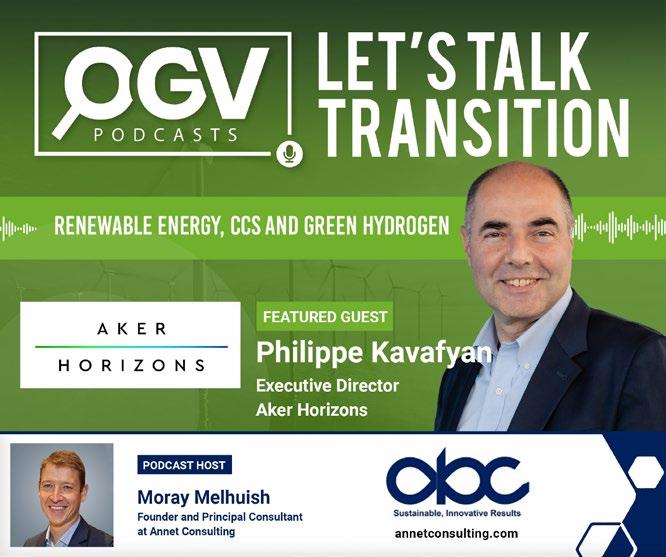

I'm a fundamental believer that hydrogen will play a significant role, but we need to put things a little bit in perspective in terms of substituting the current volume of energy
that we get from fossil fuels with hydrogen and hydrogen doesn't really make sense in all types of applications. So, there's a big debate going on in terms of should we use it for the very specific application where it's uniquely positioned to reduce emissions.
I think this is the right way to look at it. Starting from replacing the grey hydrogen that we use today in fertiliser or in other industries. Substituting this with green hydrogen as a first step is very logical. There's also some industrial applications where hydrogen will be needed to reduce very hard-to-abate sectors like the steel industry, and the cement industry.
There is a huge volume of hydrogen that will be needed if we concentrate on these very difficult, hard-to-abate industries.
Agreed and usually for an industry to adopt a fuel, it needs to be cost competitive. At what point do you see ‘Economies of scale’ kicking in and can we commoditise hydrogen?
Well with hydrogen, the biggest challenge is the cost of producing the energy. That is to say, a good 60% or 70% of the cost of producing hydrogen is directly related to the cost of the energy you put into the electrolyser. So a first approach to this is to locate the production of hydrogen in places where either solar PV or wind conditions are strong.
In that case, you would have a very low cost of energy that is reducing the cost of green hydrogen. The truth is that, like we discussed before, these locations are usually quite remote from the places where we have the demand for the hydrogen in the industrial processes. So the question there is, what is the best way to transport it?
Like we observed with natural gas, the best way to transport gases is by utilising a pipeline and the only effective way to transport hydrogen is through a pipeline, so this positions the North Sea or the South Bank of the Mediterranean sea as excellent locations where we could see a network of pipelines that could fit the European needs. In other places of the world, like in the US, you have industrial hubs that are very well equipped to use a gas network or that can be adapted to use one.
In the case of Netherlands, we already have a gas network that is suitable to become the start of the European backbone for hydrogen. So as much as possible, trying to build on the existing infrastructure from the oil and gas industry and from there, evolve things to create a specialised network for hydrogen to deliver a cost-effective and reliable transition.
I guess thinking about it then, that makes your interest in both offshore wind and hydrogen a pretty obvious combination. They are very complementary with each other?
Yes, if you go up north in the UK, the more you look at the potential of Scotland’s wind resources and the grid infrastructure, there's an obvious transition that can be built and with the local production of hydrogen and the pipeline transportation infrastructure, it will work very well and transportation of the hydrogen through a pipeline will be more effective than grid transportation of the electricity.
watch full interview www.ogv.energy/play OR LISTEN TO THE PODCAST 29 HYDROGEN & CCS
GEOTHERMAL
Everything under the surface
AGR is a multi-disciplinary engineering consultancy and software provider. We have the experience, agility and creativity to deliver a compelling solution that solves today’s and tomorrow’s energy challenges. We understand the risks. We manage projects in multi-jurisdictional regions and we understand client pressures to deliver safely, cost-effectively and carbon neutrally.
MEXICO PUBLISHES TENDER FOR DRILLING OF SIX GEOTHERMAL WELLS
The Government of Mexico has published a tender for drilling of exploratory geothermal wells in Los Negritos, San Marcos, Cerro Prieto, and Las Tres Vírgenes.
The Ministry of Finance of the Government of Mexico has announced a tender called “Acquisition of Geothermal Well Drilling Services” , for the drilling of six geothermal wells in four areas with geothermal potential, as part of a new exploratory drive by the public company CFE .

The bidding documents were issued on 7 March 2023 and the deadline to submit proposals is on 12 May 2023. The tender, supervised by the Institute of Electricity and Clean Energy (Ineel) , involves the exploration of areas such as Los Negritos, San Marcos, Cerro Prieto and Las Tres Vírgenes, and will be financed with US$51 million from the World Bank and the Inter-American Development Bank (IDB).

The purpose of the tender is to contract a single drilling services provider with two drilling rigs to perform drilling services for six (6) exploratory geothermal wells, distributed in the four mentioned geothermal areas. If the exploration is successful, the IDB will finance the CFE for the construction of a possible geothermal plant through a line of credit.
The tender is part of the program: “Financing and Risk Transfer Program for Geothermal Energy in Mexico”, under the Non-Reimbursable Financing Agreement with Contingent Recovery No. GRT/TC-14424-ME of the Inter-American Development Bank.

Earlier this year, the Secretariat of Energy of Mexico announced the grant of 22 geothermal exploration permits in Mexico, mainly in Baja California. The exploration permits were granted to conduct more detailed geological, geophysical, and geochemical studies of the geothermal areas.
TAQA AND REYKJAVIK GEOTHERMAL FORM JOINT VENTURE
The Industrialisation and Energy Services Company (TAQA) and Reykjavik Geothermal (RG) have signed a Joint Venture Agreement to establish TAQA Geothermal Energy LLC, headquartered in Riyadh, Saudi Arabia.
TAQA Geothermal will explore and develop Geothermal resources in Saudi Arabia and the Middle East and North Africa (MENA) region, contributing to Saudi and Middle East Green Initiatives’ decarbonisation targets.
The new joint venture is in full alignment with the Kingdom of Saudi Arabia’s efforts to reduce carbon emissions toward achieving Net Zero while diversifying the Kingdom’s energy mix, in line with Vision 2030.
“Today I am happy to announce that TAQA is partnering with a world-class,

well-established global leader in the development of Geothermal Resources (Reykjavik Geothermal (RG)). Together we are creating TAQA Geothermal Energy LLC, headquartered in Riyadh –KSA mandated to explore and develop the equivalent of 1GW of Geothermal power from resources in the Kingdom and to further contribute to the realisation of the Saudi & the Middle East Green Initiatives decarbonisation targets,” said Khalid Nouh, Group CEO of TAQA.
Established in Saudi Arabia in 2003 and with 54% ownership by the Public Investment Fund of Saudi Arabia, TAQA innovates, develops and deploys technologies, products and solutions to the Energy industry, enabling the performance of its customers.
“The RG team is a long-time believer in the geothermal potential of the Kingdom; we first started exploring the local resources in 2009. This clean, stable and inexpensive baseload energy source has enormous potential. It goes beyond the 1+ GW of high-enthalpy power generation, our new joint venture aims to develop to large-scale direct-use of geothermal cooling and desalination projects using the Kingdom’s plentiful low-and medium enthalpy resources,” added Godmundur Thoroddsson., Chairman of the board of RG.
Earlier this year, the Ministry of Energy of Saudi Arabia and the Saudi Geological Survey (SGS) signed a memorandum of understanding for the start of geothermal exploration in the country. With the arrival of TAQA Geothermal, there is now a huge opportunity to realise the ambitions of Saudi Arabia to develop geothermal projects.
agr.com GEOTHERMAL SPONSORED BY
Source: Secretary of Finance, Government of Mexico via our Turkish language platform PiensaGeotermia
30 www.ogv.energy - Issue 3
GEOTHERMAL – A FIRST CHOICE FOR CLEAN BASELOAD ENERGY
Karl Farrow, Founder and CEO of UK Headquartered CeraPhi Energy talks about the opportunity Geothermal presents as a viable and realistic part of the energy mix and how the skill set of the oil and gas sector could be harnessed in this transition.

In these challenging and uncertain times: climate change, rising energy costs, financial instability and the uncertainty of the geopolitical landscape, the energy we use and the security around this has become ever more important.
Geothermal as an energy source has been available for centuries and is the only true baseload energy. Available everywhere and anywhere - and with 99% of the earth’s volume having temperatures exceeding 1000ºcGeothermal is a baseload energy meaning it provides 24/7 energy and can be viewed as one giant battery with enough clean renewable energy to help meet the 2050 Paris Agreements net zero targets and to potentially last billions of years.
What is Geothermal Energy and How Does it Fit into the Energy Mix?

To meet Paris Agreement targets and set a global warming target at 1.5ºc, global energy use must transition from oil and gas to cleaner and more sustainable energy sources.
Realistically, no one source of renewable energy can completely replace the current energy supply from fossil fuels like oil and gas – and it is a blend of all energy sources that will enable this transition to happen - but what we do have to grasp is geothermal energy is always available, unlike solar and wind which are discontinuous and require ancillary systems to operate or biomass and hydrogen which require feed stock from fossil fuel or cultivated source which in turn have a damaging environmental impact. Furthermore, the key benefit of Geothermal is to provide heat directly.
Geothermal Energy is heat created from radioactive decay penetrating through the sub-surface of the earth.
Different geothermal technologies with distinct levels of maturity exist. Technology for direct use including district heating, geothermal heat pumps, greenhouses and other such applications are widely used and already considered mature. Technology for electricity generation from hydrothermal reservoirs has been used commercially for more than 100 years and is completely reliable. Yet, despite the staggering amount of Geothermal Energy
contained within the earth’s sub-surface, only 16 GWE of energy is currently being commercially produced from this source globally.
Many of the world’s continents are already utilising Geothermal Energy to meet their energy needs and there is, undoubtedly, huge potential in this sector however, the UK and the world needs to ramp up use of this viable and natural energy resource if we are to remain serious about hitting the environmental targets, we have set ourselves globally.
How Can Transition Be Achieved?
There are two strands to Energy Transition:
• The movement of energy resourcing from non-renewable energy resources to renewable energy solutions


• The repurposing of oil and gas wells for geothermal and the utilisation of an already highly skilled existing oil and gas work force who can seamlessly make the transition into the Geothermal energy space.
There are currently an estimated >20 million oil and gas wells across the world with an estimated 3.2million in the USA. Many of these are end of life and nonproducing. Acknowledging there are some differences between oil and gas and Geothermal Energy production –Geothermal requires deeper accessibility and functions at higher temperatures – the expertise and services from the oil and gas sector can access it easily.
Couple this with the existence of an already skilled work force, in the hundreds of thousands of people who work in the global oil and gas sector, and the Geothermal Energy industry has a readymade, hugely skilled work base that already uses much of the technology and work practices that would seamlessly transition into this renewable energy space.
What Does the Future Look Like for Geothermal Energy?
A huge challenge for the Geothermal Energy industry is perception. We need to look at drilling in Geothermal in the same way we look at Oil and Gas. The only difference being, with oil and gas the requirement is to get the resource as quickly as possible and then shut down the field. Geothermal is about getting the fuel for as long as possible, yes at a lower rate of return but at a longer rate of return. A baseload replacement for heat that can be monetised with a bottom line of double digits.
Wider political and funding support and a commitment to the development of Geothermal technology as a viable part of the new renewable energy mix is also much needed and – working with, and as a founder member of the Geothermal Energy Advancement Association (GEAA) - we are already starting to make significant headway accelerating the development of Geothermal solutions.
Similarly, we are already well underway advocating and initiating the migration and application of oil and gas expertise and earlier this year CeraPhi appointed Petrofac to support them on a ‘first of its kind’ study that will evaluate whether oil and gas wells in the North Sea can be repurposed for geothermal energy. The work on the Enquest Magnus - will determine whether heat from the wells can be used as a direct power and/or as a heating or cooling for services and utility.
The opportunities for Geothermal Energy as a viable, clean, continuous and secure part of the energy mix are considerable. The resources are already there in the millions of unused oil and gas wells across the world. The skill set of Oil and Gas professionals is already there to draw on with engineering skills in well integrity management, root cause analysis, corrosion and erosion, wellbore management, fracturing and stimulation all areas of expertise transferable to the Geothermal Energy sector.
The Technology
Technology is key in the production of Geothermal Energy and at CeraPhi Energy we are already well advanced in our development and utilisation. One of these technologies is CeraPhiWell™ which enables the recovery of commercially useable heat energy from the sub surface, virtually anywhere in the world. A downhole heat exchanger, CeraPhiWell™ is designed to circulate proprietary working fluids, moving the heat to the surface where it is can then be processed into direct heat or power use before being returned to the well.
Additionally, the technology offers a ‘fallback’ for those wells that fall short of production expectations and where retrofit architecture can be installed to leverage some commercial return as opposed to a costly well abandonment.
CeraPhi Energy is perfectly positioned to advance the use of Geothermal Energy both across the UK and the world and to demonstrate the real viability of this energy source as a key player in the energy mix. Our turnkey capabilities and highly skilled team are already operational on projects across the globe and continue to advocate Geothermal Energy as the cleanest, cheapest and most efficient 24/7 baseload energy.
GEOTHERMAL SPONSORED BY GEOTHERMAL
31
Karl Farrow
Landmark project puts Intelligent Plant at forefront of tidal energy
An Aberdeen-based industrial data analytics specialist has played a key role in a landmark renewables project that is helping to power thousands of homes.
Intelligent Plant worked alongside the European Marine Energy Centre (EMEC) and Orbital Marine Power to deploy a data acquisition system for the O2 – believed to be the world’s most powerful tidal turbine –located at the Fall of Warness tidal test site, off the coast of Orkney.
The system, which is linked to Intelligent Plant's Industrial App Store, allows remote access to real time, mission critical data and provides a cloud-based platform for EMEC to carry out power performance assessments for wave and tidal energy developers.
Accessibility, storage and security of data have been improved for Orbital’s operators, technicians and other stakeholders; providing cutting-edge data management
tools to monitor the performance and status of the asset while in operation. Meanwhile, the Industrial App Store has been securely integrated with the systems onboard the Orbital O2 tidal turbine.
Steve Aitken, founder of Intelligent Plant, said: “This was an incredible project to be part of as well as an opportunity to showcase the breadth and depth of technical capabilities possessed by the Intelligent Plant team.

“It was a fantastic experience to work and collaborate with both EMEC and Orbital Marine Power to successfully complete the project and deliver tangible benefits to stakeholders and local communities.
“With an ever increasing number of large renewables projects coming on stream over the coming years around the coast of Scotland and elsewhere in the UK, this creates opportunities for our business to further develop our expertise in this exciting and fast-developing industry.”
The O2 – rated at 2 MW with twin 20-metre rotors sweeping more than 600 square metres of area below the surface – is connected via subsea cable to the local electricity grid and is helping power communities in Orkney in a sustainable way.

According to Orbital, it has the ability to generate enough electricity to meet demand for around 2,000 homes and offset approximately 2,200 tonnes of carbon dioxide production every year.

Commenting on the role played by the Intelligent Plant team, Steve Aitken added: “User-friendly dashboards enable quick, secure and easy access to relevant data streams from anywhere in the world. This enables Orbital's engineers to access data from the O2 turbine in real time without a requirement for manual intervention.
“The Industrial App Store also provides data to EMEC's performance test engineers, streamlining the analysis of the tidal turbine's performance as part of EMEC's accredited testing services.”
MARINE & TIDAL
32 www.ogv.energy - Issue 3
'the O2' is believed to be the world’s most powerful tidal turbine located at the Fall of Warness tidal test site, off the coast of Orkney
Wave energy, storage pilot begins Orkney trials
Eni installs new wave device off Italy
Eni has completed the installation of the world's first Inertial Sea Wave Energy Converter (ISWEC) device connected to the electricity grid of an island.
The wave energy device is located about 800 metres off the coast of the Italian island of Pantelleria and can reach 260 kW of peak power generation converted from wave energy.
This experimental campaign, conducted under real operating conditions, will lead to useful results for developing the second-generation device under study, Eni said.
ISWEC was developed by Eni in collaboration with the Politecnico di Torino and Wave for Energy (a spinoff of the university).
The technology converts wave motion into electricity which then supplies energy to offshore infrastructure, small off-grid islands and coastal communities.
ISWEC design can be optimised with reference to the metocean conditions of the site where it is installed by means of a genetic algorithm that leverages on the significant computing power of Eni’s Green Data Centre (GDC) based in Ferrera Erbognone.
Acollaborative project to power subsea equipment with wave power and subsea energy storage has taken to the seas in Orkney, Scotland.
The £2m demonstrator project, called Renewables for Subsea Power (RSP), has connected Mocean Energy's Blue X wave energy converter (pictured) with a Halo underwater battery developed by Aberdeen intelligent energy management specialists Verlume.

The two technologies have been deployed in the seas off Orkney and have now begun a minimum four-month test programme where they will provide low carbon power and communication.
They will also provide infrastructure including Baker Hughes’ subsea controls equipment and a resident underwater autonomous vehicle provided by Transmark Subsea.
The European Marine Energy Centre (EMEC) has supplied instrumentation to measure the speed and direction of currents during the deployment, whilst Wave Energy Scotland has provided £160,000 to support the integration of the umbilical into the wave energy converter.
The project aims to show how green technologies can be combined to provide reliable low carbon power and communications to subsea equipment, offering a cost-effective alternative to umbilical cables, which are carbon intensive with long lead times to procure and install.
The Orkney deployment is the third phase of the Renewables for Subsea Power project
which is being supported by consortium partners which include UK-based energy companies Harbour Energy and Serica Energy.
Each phase of the programme has also been supported by grant funding from the Net Zero Technology Centre (NZTC).
In 2021, the consortium invested £1.6m into phase two of the programme – which saw the successful integration of the core technologies in an onshore commissioning test environment at Verlume’s operations facility in Aberdeen.
They are now testing the entire system at sea at a site 5km east of the Orkney Mainland, raising the system’s technology readiness level (TRL) to 6-7 (actual system completed and qualified via test and demonstration).
In 2021, Mocean Energy’s Blue X prototype underwent a programme of rigorous at-sea testing at the European Marine Energy Centre’s Scapa Flow test site in Orkney where they generated first power and gathered significant data on machine performance and operation.
The Blue X programme was made possible through £3.3 million from Wave Energy Scotland which supported the development, construction and testing of the Blue X prototype at sea.
Mocean Energy managing director Cameron McNatt said: "This is a natural next step for our technology.
"The new test site east off Deerness offers a much more vigorous wave climate and the opportunity to demonstrate the integration of a number of technologies in real sea conditions."
Wavepiston to develop Martinique wave project
Danish ocean energy outfit Wavepiston and YS Energies Marines Developpement (YSEMD) have signed an agreement to codevelop a wave energy project in Martinique.
The development aims to provide clean energy for the local communities on the island.
“This agreement could lead to a new frontier of clean energy and clean water in the Caribbean, leveraging the region's abundant wave energy resources and speeding up the energy transition," said CEO of Wavepiston Michael Henriksen. The agreement is the result of a preliminary site selection study that was done in 2021-22.
The study identified the wave energy potential of the area and the most suitable locations for the project.
As a result, the companies have now joined forces to kick-start the project development.
“We are convinced that wave energy is now ready for a commercial phase and will play an important role in the decarbonisation of islands’ electricity mix around the world.
“The co-development agreement with Wavepiston is the first step towards the deployment of wave energy arrays and we hope that it will pave the way for further development,” said CEO of YSEMD Corinne Dubois.
Wavepiston is installing the first full-scale system off the coast of Gran Canaria and in parallel preparing first commercial projects.
MARINE & TIDAL
33
Image: Mocean Energy
SPONSORED BY
Decarbonisation through intelligent energy management
With a track record of firsts, we are a leader in world-class intelligent energy management and storage technologies for decarbonisation of the energy sector.
verlume.world
We offer a suite of products and services that are agnostic from a power generation and power demand perspective, with applications across the underwater, offshore and onshore sectors.
Utilising enabling technology to unlock CCS potential
By Andy Martin, Chief Commercial Officer, Verlume

Within the United Kingdom, a similar licencing round saw 26 bids submitted in 2022 to the North Sea Transition Authority. Through this licencing round, the first injection of CO2 is predicted to take place in 2027. The UK Government has also handed out separate funding to projects such the Northern Endurance and the East Coast Cluster, as well as Hynet North West.

In Scotland, the Acorn project (a joint venture between Storegga, Shell UK, Harbour Energy and North Sea Midstream Partners) could have significant potential for the north east of Scotland’s decarbonisation efforts. Despite having been unsuccessful in the UK Government’s Track 1 carbon capture and storage funding, the results of Track 2 funding are expected to be made public in the spring.
storage system has been designed and optimised for use in harsh, deepwater environments to provide energy security, with low carbon power through integration with any type of renewable energy device such as wave energy converter, tidal turbine or solar array. This also helps to overcome the challenges of renewable intermittency.
Another important factor to consider is the requirement for long-term monitoring of CCS sites. Power capabilities will be required here, as well as real-time data and communications. Halo can enable wide area monitoring through remote, autonomous or semi-autonomous subsea inspection of lengthy pipelines, umbilicals, and cables through an integrated docking station for a resident autonomous underwater vehicle.

Operational intelligence is provided through a central node for data processing, creating a network of wireless sensors that are configured to create a subsea internet of things. Within Halo, there is an integrated intelligent energy management system known as Axonn which is capable of resource and yield analysis, assessment of energy resource at a project location to determine the optimum power generation system, as well as capacity analysis.
Carbon capture and storage (CCS) has been identified as a key facilitator to reducing industrial carbon dioxide (CO2) emissions. In the offshore environment, the technology can capture high concentrations of CO2 for underground storage in naturally occurring storage areas such as aquifers or within existing infrastructure previously built for offshore energy activities. By capturing the greenhouse gas instead of it being released into the atmosphere, CCS will therefore become a critical part of reducing worldwide emissions.
Global and Local Action
The first cross-border, opensource CO2 transport and storage infrastructure network is already in progress with collaboration between Equinor, Shell and TotalEnergies as part of the Northern Lights project offshore Norway. With an annual CO2 capacity of up to 1.5 million tonnes, phase 1 of the project is set to be completed in 2024.
Also in Scandinavia, Denmark awarded its first CCS licences in February to Wintershall Dea, INEOS Energy and TotalEnergies.
Opportunity for Existing Skills and Technology
As with many elements of the energy transition, skills transfer will be a vital to make change possible at pace. Since much of the infrastructure required for CCS is underwaterbased, there is a significant opportunity for knowledge flexing from the subsea oil and gas market. Similar infrastructure, from injection trees, pipelines, wellheads and control systems, will mean that experience transfer from this market will be fundamental.
For CCS infrastructure to operate reliability with a focus on operational emissions, there will be the requirement for remote and zero carbon power. With most of the current CCS projects set to be located far from shore at distances over 100 kilometres, I do not believe that it will be economical to deliver kW-scale power from shore via umbilical cables.
An economical solution would be Verlume’s Halo system. The seafloor battery energy
We are enthusiastic to engage with CCS project developers to discuss how Halo can act as an enabler to allow CCS to be utilised to its full potential as a key player in the energy transition.

Please get in touch if you would like to discuss how we can deliver the valuable missing link that can reduce your carbon footprint at info@verlume.world

ELECTRIFICATION
ELECTRIFICATION
34 www.ogv.energy - Issue 3
Andy Martin
Electrification Will Define The Energy Transition And Not The Current Crisis
By Sverre Alvik, Director of the Energy Transition Research Program in DNV


To build an energy system that is secure, affordable and sustainable requires an understanding of how today’s challenges inform the long term.
The current energy crisis feels very urgent, but in the longer-term electrification is much more impactful for the pace of change. The production of electricity is expanding in all regions and almost all sectors, while the electricity mix itself is greening rapidly. Electricity production will more than double, with the share of electricity rising from 19% to 36% in the global energy mix over the next 30 years. In addition, electricity will take over and dominate hydrogen production.
Many households in the northern hemisphere have been waking up to the first frost of the winter season. With energy prices soaring, consumers will be nervously checking their smart meters as they switch on their heat pumps and set the timer on their gas-powered hot water boilers.
Governments are instinctively focused on the short term and many are concentrating their efforts on getting their citizens through the tough months ahead. But part of the reason we arrived at this difficult moment was because the energy system, for many countries, did satisfy all corners of the energy trilemma. In Europe, for example, the reliance on cheap imported gas has exposed the risk of concentrating too much on cost over security.
The sixth edition of DNV’s Energy Transition Outlook shows how a two-speed transition is unfolding in the short term. Europe is doubling down on its renewable commitments whilst the rest of the world is concentrating on the short term shocks with a less clear longer term direction. Europe’s decision to turn its back on Russian gas will have a dramatic impact on its energy mix: compared to last year’s forecast, we see the continent consuming almost half the amount of natural gas in 2050. Gas will meet just 10% of Europe’s energy demand in 2050 compared with 25% today.
Lower-income countries, where cost is the main driver of energy policy, are seeing a different trend. High energy and food prices are reversing the coal-to-gas switch and putting a dampener on decarbonisation investments. For example, the share of gas in the Indian subcontinent’s energy mix will reduce from 11% to 7% in the next five years, while the share of coal will increase.
Schneider Electric CEO speaks to electrification challenges, opportunities
Jean Pascal Tricoire, Schneider Electric’s Chairman & CEO, spoke at CERAWeek reinforcing the importance of digitisation and infrastructure investment to address our current and future energy challenges.
Joining a panel of experts for a discussion entitled, “The Electrification of Everything?”, Tricoire shared his thoughts around the challenges and opportunities as we move toward the new electric future. Here are a few statements he made:
“We underestimate the change coming in the electrical system and the way it will be managed in the future. The challenge is even bigger than we described. Today, electricity is only 20% of energy consumption, but that will be 40-60% in the next 20 years. A large section of the electrical infrastructure will be built over that next 20 years allowing us to rethink how we do it. The fundamentals for that will be built around security and resiliency.”
“With the technology available, it’s possible for every company to be more resilient and I believe the first step is to empower all to be more responsible in what we do with their energy. In the US, we could leverage distributed energy resources – only about 15% of homes have smart thermostats and only 40% of buildings are smart buildings. In Europe, less than 10% of buildings are smart buildings so they can’t adjust their energy consumption. So here, you have a huge reserve of possibilities. In the U.S. today, we also have the largest amount of microgrid projects – large customers taking charge of their energy resiliency and security based on renewables backing up the grid. If you combine greater efficiency with local generation, this will reduce the pressure on utilities, then it’s a shared responsibility between users and utilities.”

“What’s coming is energy transition? Cars, heating systems, everything will be far more electric. This revolution is now happening in the US and Europe and everywhere around the world Technology allows you to ensure this digitisation and security at the local level – combined with a grid that will be infinitely more intelligent – that will be more
Solar PV and wind are already the cheapest form of new electricity in most locations and by 2050 they will grow 20-fold and 10-fold respectively and will dominate electricity production with 38% and 31% shares, respectively. Energy security concerns are leading to renewed interest in nuclear, and the forecast this year reflects a modest uptick, growing by 13% from today’s levels to 2050. However, its share of the electricity mix will still reduce from 10% today to 5% by 2050.
For the first time, our forecast sees nonfossil energy nudge slightly above 50% of the global energy mix by 2050. However, it should be noted that even after a pandemic and war in Europe, both of which have required massive policy action, our forecast for the energy mix is broadly the same compared to when we first published the Energy Transition Outlook. This is an indication of the size of challenge ahead for policymakers heading to COP27.
connected to the consumer. The internet has revolutionised the way we live together. We need to be prepared for the same kind of revolution over the next 20 years in the way we manage energy. Everything connected, everything electric and you being empowered.”
“What do we need to do to address our current challenges? It’s time that we rebalance the debate on the demand side. I’m always surprised when people discuss the energy transition, the focus is on supply when the transition is always driven by demand – that’s number one. Number two is money. Take Europe – last year we spent 6 million euro in soothing the pain of consumers around the cost of energy. What if we had invested that 600 million into accelerating the transition to another way of dealing with the issue? This is what the IRA is doing here. The third thing is simplifying regulations. Regulation on energy is now done on a system of yesterday and not policies focused on tomorrow. How can we simplify that so all of us can participate?”
“Another bottle neck is that all the technologies we are discussing are new technologies. Nobody has been trained at scale to deploy them. How many people do you need in the US to go from 40% to 100% of smart buildings or from 15% of smart homes to 100%? Great jobs on the boarder of energy and digital. Jobs of the future that will be needed all over the world. Currently, there are almost no schools teaching these skills, which is an issue. As Schneider, we are training 1 million people as we speak through partnerships, but this is one of the biggest challenges as we begin the energy transition.”
ELECTRIFICATION SPONSORED BY ELECTRIFICATION
35
Solar farms can benefit food security
Source: SEUK
Solar farms deliver significant benefits for the environment on a number of levels.
Renewable, sustainable electricity and biodiversity improvements are the most commonly known, but research is now bringing additional benefits to light. Solar Energy UK, the UK’s solar trade association, has shone a light on new research that suggests that solar farms can contribute positively to food security by enhancing pollinator biodiversity. SEUK writes that if we were to put honeybee hives on every solar farm in England, we could have gained £5.9m worth of pollination service benefits. Careful planning to locate pollinatordependent crops next to solar farms could theoretically have delivered up to £80 million!

This new information reveals that good management of solar farms could be a “winwin-win scenario for climate change mitigation, biodiversity conservation and food security” and is further support for the importance of developing projects that go beyond solar. At Lightsource bp, we’re dedicated to enhancing biodiversity under our Sustainability strategy, and have committed to delivering a Biodiversity Net Gain (BNG) for each of our projects after five years of operation.
Control Systems for the Next Generation
RCP are a leading supplier of solar power and battery back up systems typically used for “off-grid” applications, offering a safe and reliable energy source, available to power your critical equipment in remote and hazardous environments.


cut soaring bills
Source: euronews.com
In a town north of London, the weather's been cloudy over the winter months.
But it didn't stop this homeowner from installing solar panels in December.
On his smart metre, Kumi Thiruchelvam looks satisfied at the "0 watts" showing up under electricity. It's about 10 am, and he's not using any electricity from the grid.
Cost of installation? Between £12,000 and £13,000 (€13,500-€14,500), a fair chunk of savings, even for Thiruchelvam, who lives on a private avenue in Luton.
The investment was common sense for him following the surge in energy prices. According to the Office of National Statistics, electricity prices in the UK had increased by 67 per cent in January 2023 compared to January 2022.
Solar power installations doubled in 2022 compared to 2021, according to MCS, the standards organisation in charge of solar installations.
"We've had a combination of soaring energy prices around the world, and then also we've increased our electricity consumption in the home through a number of reasons, including electric vehicles," says Thiruchelvam.
His family owns a big house and no less than three electric vehicles, so their electricity consumption is higher than the normal household, about 12,000 kWh per year.
Around two-thirds should now be provided by solar panels.
"We originally sought the configuration to be rear, which is where the sun comes up, but we went for the front because it spends more time in the front throughout most of the year than in the rear. Also, there's more shade in the rear with trees," he says.
Plans for solar farm in Herefordshire to power 9,000 homes

Source: bbc
Plans to build a solar farm to power 9,000 homes in Herefordshire are being recommended for approval.
The proposed 25MW installation is set to be built near the villages of Westhide and Withington, near Hereford.
Forty public objections have been made and two parish councils oppose the plans, the Local Democracy Reporting Service (LDRS) says.
Herefordshire councillors are being recommended to approve the plans when they discuss them on Wednesday.
The solar farm would be made up of more than 45,000 panels across four fields and the plans from Ersun (Westhide SPV) Ltd include security fencing and CCTV.

Ocle Pychard Group Parish Council said it still objected to the proposals, adding concerns over noise pollution and flooding were not addressed.
Withington Parish Council said it was also opposed, LDRS said.
But no objections have been made by groups including the Environment Agency or Herefordshire Council's officers.
SOLAR
rcpat.com solar SPONSORED BY
Solar panel sales double in the UK as homeowners look to
36 www.ogv.energy - Issue 3
Belgian
partners use new offshore floating PV to complement wind

Source: solarmagazine.com
Belgium-based partners Tractebel, DEME and Jan De Nul recently introduced their patent-pending SEAVOLT offshore floating PV technology.
This technology is a result of joint research and development by the partners and Ghent University under the VLAIO-funded (Belgium's Flemish government's Agency for Innovation & Entrepreneurship) research project MPVAQUA (Marine PV Aquaculture) within the frame of Blue Cluster.
SEAVOLT stems from growing land scarcity for solar deployment, combined with the desire for local production without remote transmission and the need for rapid acceleration of the energy transition.
Over the past few years, the complementarity between wind and solar technology has been confirmed worldwide. This results in increasing authorities allowing multi-use concessions, driving comprehensive assessments of technical and environmental site data at many potential offshore wind sites. Meanwhile, the grid infrastructure also shows good potential for combined use.
"In the same way that we have seen wind technology moving from land to the sea, we
Sarcos robotic solar field construction solution completes final validation
Source: solarmagazine.com

Sarcos Technology and Robotics Corporation announced it has completed the final validation of its Outdoor Autonomous Manipulation of Photovoltaic Panels (O-AMPP) project.

During the field trial, Sarcos collaborated with leading companies involved in the renewable energy industry, including Mortenson, JLG Industries, Array Technologies and Pratt Miller, to achieve this critical milestone at a Mortenson project site, which validated the Sarcos robotic solar field construction solution.
"Achieving this market validation and field test milestone is a mission-critical step on our path to commercialising our robotic solar field construction solution and, ultimately, enhancing safety and productivity in the solar field construction industry," said Kiva Allgood, President and CEO of Sarcos.
are seeing the extension of the whole energy system towards offshore locations," said Philippe
Van Troeye, CEO of Tractebel.
"Along with offshore green fuel production, offshore energy islands and interconnectors and potential solutions for energy storage, we believe offshore floating PV has an important role to play in the acceleration of the energy transition."
SEAVOLT floating PV technology can withstand harsh offshore conditions while creating large surfaces that are protected from the waves. It utilises a modular design that easily adapts to different sites and project demands. As a whole, it enables local energy production and the possibility of installing panels in offshore wind farms, adding large volumes of renewable energy in a relatively short time.
A marine floater concept was already developed together with initial research on effects on the marine ecosystem, integration of aquaculture and a financial assessment. Following laboratory testing, the partners are developing an offshore test installation which will be launched off the Belgian coast this summer. Furthermore, parallel studies focusing on the ecosystem, the environment and cost-effectiveness are underway.
UK wind, solar builders seek urgent response to US, EU aid
Last month, five energy trade groups warned the UK lacks a "clear government plan to deliver green economic growth” and risks losing investments following new support measures implemented in the U.S. and the European Union. In a letter to government, RenewableUK, Energy UK, Scottish Renewables and Solar Energy UK and the Nuclear Industry Association, called for the introduction of an investment allowance in the new Electricity Generators Levy, imposed by the government to limit excessive power revenues in 2023-2028, as well as a greater capital tax allowance.
The UK should also adapt renewable energy subsidy regimes to help mitigate against rising costs, developer Vattenfall told Reuters Events. Vattenfall has been a key player in offshore wind, the UK's largest renewable energy sector, and also develops onshore projects.
The call to government comes as UK Chancellor Jeremy Hunt prepares the Spring Budget for March and power authorities prepare to allocate renewable energy contracts in a fifth licensing round.
Companies fear $369 billion of green subsidies in President Biden’s Inflation Reduction Act and a looming EU support package will widen the competitive gap and lure investors away from the UK. The U.S. inflation act includes tax credits for renewable energy manufacturing and deployment while the EU's Green Deal Industrial Plan temporarily relaxes state aid rules and simplifies regulation, allowing member states to support their own supply chains.
We are excited about the possibilities and potential impact of the O-AMPP system in solar construction," said Trent Mostaert, Vice President of Industrialisation at Mortenson.
According to the Solar Energy Industries Association (SEIA), annual solar installations must increase by 60% between now and 2030 to meet the Biden administration's target for solar to reach 30% of U.S. electricity generation by 2030. SEIA estimates that the industry requires a workforce expansion of nearly 900,000 new workers to meet this goal.
"We believe the O-AMPP system can address these challenges while improving safety, productivity, and efficiency for our workers. It will also enable solar project developers to scale output and production to the levels needed to achieve the Energy Department's 2030 and 2050 renewable energy goals.

The O-AMPP project, which began in 2021 with funding support from the U.S. Department of Energy Solar Energy Technologies Office (SETO), aims to streamline the process of solar field construction into one harmonised robotic system to deliver, detect, lift and place PV modules in the field. The benefits for energy companies implementing the system for solar construction include lower soft costs for projects, the ability to engage in more projects simultaneously, improved construction timelines and quality, and a safer worksite that reduces the risk of injuries, including lifting and fatigue-related injuries.
During the validation of this system, a proofof-concept O-AMPP system consisting of an Autonomous Working Vehicle (AWV) featuring the Guardian® XM robotic system and an Autonomous Delivery Vehicle (ADV) was used to optimise the flow of PV modules from delivery to installation.
Sarcos expects to commercially launch its robotic solar field construction solution in 2024.
SOLAR SPONSORED BY
SOLAR
37
contracts

contract awards
Infinity Partnership: Your Partner in Business

Infinity Partnership is an award-winning, multi-disciplinary accountancy and business advisory practice, with a proactive approach to customer service.

www.infinity-partnership.com
Infinity has been a five-time winner at the British Accountancy Awards and has been a three-time finalist at the Scottish Accountancy Awards in recent times.
Air Liquide and Sasol sign new set of long-term contracts to supply an additional 260 MW of renewable energy to the Secunda site
Air Liquide and Sasol have signed two Power Purchase Agreements (PPA) with TotalEnergies and its partner Mulilo for the long-term supply of a total capacity of 260 MW of renewable power to Sasol’s Secunda site, in South Africa, where Air Liquide operates the biggest oxygen production site in the world. This is the second set of PPAs signed by Air Liquide and Sasol, after the PPAs announced in January with Enel Green Power for a capacity of 220 MW. Together, these PPAs represent a total of 480 MW of the joint commitment by Air Liquide and Sasol to pursue the procurement of a total capacity of 900 MW of renewable energy. These will significantly contribute to the decarbonisation of the Secunda site.
Within the framework of these agreements with Air Liquide and Sasol, TotalEnergies and Mulilo will create one local majority owned wind project with a capacity of 140 MW and one local
majority owned solar project with a capacity of 120 MW. These projects are scheduled to be operational in 2025. This agreement is subject to regulatory and financial approvals.
Ronnie Chalmers, Vice President and Executive Committee Member of the Air Liquide Group, in charge of Africa Middle East & India, said: "Not only will these renewable energy capacities significantly contribute to the decarbonisation of our operations in Secunda, where we operate the biggest oxygen production site in the world, they will also actively support the development of renewable energies in South Africa, for the benefit of the South African electrical power system and ultimately of the South African society. In line with Air Liquide’s ADVANCE strategic plan, which includes reducing its absolute CO2 emissions by 33% by 2035, these PPAs also demonstrate the Group’s capacity to collaborate with its customers to provide solutions which contribute
RVO Awards Contracts for Metocean Campaigns Offshore Netherlands
to the decarbonisation of its assets as well as of its clients."
In April 2021, Air Liquide and Sasol launched a joint initiative to procure a total of 900 MW of renewable energy for their operations in Secunda, with an allocation of 500 MW to Sasol and 400 MW to Air Liquide. The two companies are negotiating additional PPAs to complete the balance of the renewable energy requested.
The Netherlands Enterprise Agency (RVO) has awarded contracts to GEOxyz and RPS adviesen ingenieursbureau B.V. for the execution of metocean campaigns at three offshore wind zone areas in the Netherlands.
The tender, which was divided into three lots, outlines that the data is obtained by means of two individual floating LiDAR systems and one spare to measure wind, wave, and current properties.
Downing wins contract for 28 UK solar sites
Air Liquide acquired Sasol’s 16 oxygen production units in Secunda and has been operating them since June 2021, in the framework of a long-term supply contract with its long-term partner. Including another Air Separation Unit (ASU) it already operated for Sasol, Air Liquide thus now operates a total of 17 ASUs in Secunda, with a total capacity of 47,000 tonnes/day of oxygen. Air Liquide plans to reduce by 30 % to 40 % the CO2 emissions (Scope 2) arising from its operations on the Secunda site through a multi-year investment and modernisation plan and a steep increase of the site’s procurement in renewable energies.
The preferred starting date for Lot 1 was the fourth quarter of 2022, and the preferred starting date for Lot 2 and Lot 3 is the first quarter of 2023.
Lot 1 and Lot 2 for the supply of the metocean data were awarded to GEOxyz with a total value of the contract (excluding VAT) being EUR 3.1 million and EUR 2.3 million, respectively.
Lot 3 was awarded to RPS advies- en ingenieursbureau B.V. with a total value of the contract (excluding VAT) EUR 3,627,335.
In March 2022, the Dutch Government designated three new areas and confirmed previously designated areas in the North Sea for the development of offshore wind farms with a combined capacity of 10.7 GW.
The three new wind energy areas were given the following names: Nederwiek, Lagelander, Doordewind. The other two reconfirmed areas are the northern part of IJmuiden Ver and the southern part of Hollandse Kust (west).
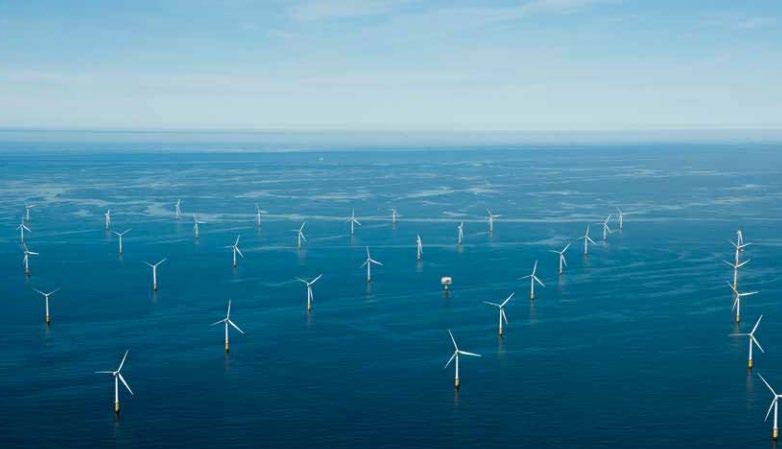
SPONSORED BY
38 www.ogv.energy - Issue 3
Apollo secures engineering deal for Celtic Sea substation
Apollo has received a contract from Celtic Sea Power to develop a floating offshore wind test site in Wales.

The contract covers the pre-FEED for the 400MW Pembrokeshire Demonstration Zone Multi-connection Offshore Substation (PDZ MOS) and two 1GW MOSs targeting the Crown Estate Refined Area of Search (RAoS) A.
Located 19 km off the Pembrokeshire coast, the PDZ MOS project is designed to allow offshore renewable energy technology developers easy access to a consented test site complete with a grid connection to prove their technology in the offshore environment.
Partly funded through the European Regional Development Fund the project also aims to stimulate further investment in the region for the floating offshore wind market.
Additionally, the two 1GW MOSs being developed for the RAoS A will demonstrate what a coordinated grid connection could look like for the commercial developments in the Celtic Sea.
This award builds on a successful collaboration between Apollo and Celtic

Técnicas Reunidas wins engineering contract for hydrogen plant in Spain
The Spanish engineering company Técnicas Reunidas has been awarded an engineering contract for the development of a large-scale green hydrogen generation plant to be built in Andorra, Teruel, Spain.
The contract includes the plant configuration study, the preparation of relevant technical documentation for permits, and a full cost estimate.
The first stage of the awarded Catalina project, undertaken by Copenhagen Infrastructure Partners (CIP), in partnership with Enagás Renovable, Naturgy, and Fertiberia, consists of the development of a 500 MW green hydrogen generation plant.
In the second phase of the project, the green hydrogen production capacity is expected to increase to 2 GW. To note, this production is supposed to cover 30% of Spain’s current demand for green hydrogen.
According to Técnicas Reunidas, the hydrogen

Edda Wind Nets CSOVs Contracts with Vestas
Offshore wind service vessel company Edda Wind has signed contracts with the Danish wind turbine manufacturer Vestas for its commissioning service operation vessels (CSOVs) in 2024 and 2025.
According to Edda Wind, the contracts total a minimum of 750 days of firm work with options for extension of each work scope.
The company recently placed a EUR 250 million order with Vard for four new CSOVs, with options for ordering up to four additional vessels.
produced at the plant will be transported via a pipeline 221 kilometres (km) long to major industrial customers in the Mediterranean area, including a newly built, state-of-the-art green
Sea Power in the concept phase to help define the offshore design envelope and onshore connections of the assets.
Jonathan White, Regional Director of Apollo said: “This contract award builds on a successful first phase of the project and underpins the competency and quality of the engineering team at Apollo.
“The PDZ MOS is a unique opportunity for the region to become a leading presence in the emerging FLOW market and we look forward to a continued relationship with Celtic Sea Power to help realise this important project.”
Nigel Jones, Technical Manager at Celtic Sea Power added: “This pre-FEED activity will further refine what good looks like for a coordinated approach to bringing up to 2.4GW of power into the electricity transmission system in south Wales. Apollo’s work will focus on deliverable designs that align with the aspirations for offshore coordination in the UK underpinning Wales’s policy ambition for a stronger, greener better Wales.”
To note, the first phase is expected to begin operations in 2027, and Técnicas Reunidas said that it is estimated that in the first stage, Catalina will contribute to the avoidance of almost 0.4 million tonnes of CO2 emissions per year.
José Gómez-Arroyo, Catalina Project Director, stated: “Catalina is a firstof-a-kind large-scale green hydrogen project that will contribute enormously to the energy transition and emissions avoidance of Spanish industry, and to European energy independence.”
“We are happy to announce our partnership with Técnicas Reunidas and we look forward to working with them in the next phase of Catalina’s development.”

Gonzalo Pardo, Commercial Director for Power and the Energy Transition of Técnicas Reunidas, stressed: “This contract is yet another example of our company’s firm commitment to projects related to energy transition and decarbonisation as it adds to the long list of initiatives that we have been developing for three years in relation to green hydrogen, the circular economy, and carbon capture.”
Once these four newbuilds are delivered, Edda Wind will have a fleet of 14 vessels, of which two are currently in operation, with five more expected to commence operation this year.
Last month, the company took delivery of the CSOV Edda Boreas which is scheduled to start working at the Dogger Bank Wind Farm in the UK this May.

The vessels that will serve the contracts are to be nominated from Edda Wind’s fleet of CSOVs at a later stage, the ship owner said.
All CSOVs in the fleet can accommodate 120 persons and are prepared for zero-emission operations with hydrogen as an energy carrier in a Liquid Organic Hydrogen Carrier (LOHC) concept.
When it comes to Vestas, the turbine manufacturer recently acquired ST3 Offshore in the sixth tendering round since the Polish offshore steel foundations maker declared bankruptcy.
contracts
contracts SPONSORED BY
ammonia plant with an annual production capacity of up to 247,000 tonnes, as well as to other refining facilities and tile companies.
39
SPONSORED BY
www.normanbroadbent.com

We have a simple and straightforward objective: to help our clients manage and successfully drive change, mitigate risk, grow, and succeed.
To feature new senior hires and appointments within your organisation, please contact Jordan Clarke, Head of Marketing & BD at Norman Broadbent. +44 (0) 7912 564 797 / jordan.clarke@normanbroadbent.com
Chris Smith, Partner


Chris is a Partner at Norman Broadbent Group and leads the international Power, Renewables & Utilities practice. He assists investors, developers, asset owners and service providers with executive recruitment (C-suite / SVP / Director levels), leadership assessment and planning proactively for future challenges around human capital.
Prior to Norman Broadbent, Chris worked for a smaller boutique search firm and gained broad experience supporting clients across EMEA, the Americas and Asia Pacific within the following sub-sectors: utilities (water/gas/electricity), offshore/ onshore wind, nuclear, hydrogen, CCUS, waste to energy, conventional power, energy storage, EV infrastructure and industrial engineering.
Alongside his extensive talent management advisory experience, Chris is formally accredited by the AESC (Association of Executive Search & Leadership Consultants) and a qualified psychometric and behavioural competency assessor.
Venterra makes three senior appointments. The offshore wind servicing company grows in Europe, Americas and APAC regions.
Offshore wind servicing company Venterra Group has appointed three senior executives to drive its global business development.
Paul Alcock (pictured) becomes group business development director based in London, Scott Anderson is appointed as vice president, for AsiaPacific and Drew Carey is the new vice president for the Americas.

The roles will be to represent the group’s expanding activities in the fast-growing UK and European, Asia Pacific (‘APAC’) and Americas offshore wind markets working closely with our member companies.The business aims to generate accelerated growth in the fast-expanding market and urgently add the skills and capabilities needed for the energy transition.
Venterra’s chief executive officer Rob Jewkes said: "We are delighted to have three such talented and experienced executives driving growth alongside our member companies in key regions of our global market. Paul has led Acteon’s new business and closer integration of services in the renewables segment, responding to client needs formore coherent, joined up activities. Scott will lead the development of Venterra’s growing presence in Japan, Korea, Taiwan and Australia. Drew has been a true pioneer bringing marine science into US offshore wind. He will capitalise on Venterra’s newly opened office in Providence, Rhode Island and our member companies’ growing work with US developers as they build local supply chains.”
2


BP Names New Onshore Renewables Head After Latest Departure.
BP's head of onshore wind and solar David Anderson will step down at the end of the year, the company said on Friday, the latest veteran departure under renewables boss Anja-Isabel Dotzenrath.
Anderson, who has been with BP for over 16 years, will be replaced by Noelia Álvarez Marivela, who joined BP from EDP Renewables in August 2022, BP said in a statement to Reuters.
Dotzenrath herself joined BP in March last year after heading RWE Renewables in what BP CEO Bernard Looney hailed at the time as a sign of how the energy company was attracting executives experienced in renewables to help BP shift away from oil and gas.
She has overseen large staff growth and changes in her division, bringing in several highprofile hires such as Matthias Bausenwein who joined from Danish wind power firm Orsted to lead BP's offshore wind division.
GE Renewable Energy appoints new HR leader for Middle East, North Africa and Turkey

GE Renewable Energy recently appointed Sultan Albalawi as HR Leader – Middle East, North Africa and Turkey (Renewable Energy, Grid Automation)
Having about 18+ years of experience as a practitioner in driving HR strategy, Sultan has been driving HR strategy in HR businesses
European Energy has announced that Jacob Gotfred Johansen will take over the reins as executive vice president, head of asset management from 1 March. Johansen is current Head of Business Performance at Maersk Drilling. In his new role, Johansen will be in charge of the company’s 1GW of renewable energy capacity in the form of operational solar and wind parks. The company is also responsible for the operation of a number of other renewable energy projects that the company does not own itself.
Johansen said: "I think that European Energy is one of the most interesting Danish companies at the moment. Today, European Energy is involved in more than 24 countries with renewable energy projects. I am looking forward to becoming part of the team and the great task of internationalising the operation and ongoing maintenance of our assets."
partnering, transforming cultures, people’s capabilities, talent acquisition, and change management. He has demonstrated success in working across multiple industries and companies in leading several HR projects and initiatives and developing trust and building effective partnerships.
Sultan will be responsible for executing key HR initiatives and driving the regional HR strategy and HR functional excellence. He will also enable process improvement for Renewable Energy – Grid Automation and HRBP for Digital Saudi & Bahrain.
ON THE MOVE
European Energy appoints new Renewable Assets Head.
1 4 3
40 www.ogv.energy - Issue 3
Chris Smith, Partner
Seven Director appointments bolster Arup energy business
Global sustainable development firm Arup has announced seven new senior leaders to strengthen its energy offering. Jemima Bruin-Bland, Neil Copeland, Mike Copson, Craig McCafferty, Graeme McCann, Sally Prickett and Robert Silver will help the firm to place sustainable development at the heart of its business.

Arup is a collective of designers, consultants and experts working globally. In the UK, its 45-strong Operations Consulting group – mostly based in London and Solihull offices – is a multi-disciplinary group bringing together specialist skills in people, processes and assets to deliver excellence to our clients’ operations.
Part of that includes a growing focus on sustainable development. The firm itself has pledged to go Net Zero by 2030, while also assisting clients with the shift, and supporting numerous clean energy projects around the world.
Mark Neller, Energy Business Leader, UKIMEA, at Arup, commented, “We are excited to welcome our new colleagues to Arup. Their recruitment is part of a wider plan to strengthen the leadership of our Energy Business and more generally, build capacity and capability to accelerate the energy transition and support our clients thrive through the journey to net zero.”
5 6 7 8

Iberdrola names Felipe Montero CEO of new German business.

Iberdrola has integrated its business activities in Germany under the name Iberdrola Deutschland and has appointed Felipe Montero as CEO of the new company.
Iberdrola Deutschland, a fully owned subsidiary of the Spanish energy giant Iberdrola, will be headquartered in Berlin and will focus on the operation of large renewable energy assets and the supply of energy transition-related services. Its offshore and onshore divisions will participate in the planning, construction and operation of wind farms and solar plants. The commercial division will offer commercial and industrial customers various supply solutions, and the integrated solutions division will support storage and hydrogen solutions for industrial use.
Newly appointed CEO of Iberdrola Deutschland, Felipe Montero, said in a statement: “The combination of all activities under one roof with an integrated 360° business model allow us to offer our customers and partners the best services to achieve their decarbonisation targets while leveraging the capabilities of the global Iberdrola group.”
Ougaard joins the company from Vestas Wind Systems, where he, since 1999, held a number of senior positions including Chief Operating Officer for Vestas Offshore and for MHI Vestas Offshore Wind and most recently Head of Construction for Vestas in Northern, Central and Eastern Europe.
Ougaard will join the company as of 1 March, 2023.
Bladt appoints new Chief Operating Officer
Flemming Ougaard will take on the role from March this year.
Bladt Industries has appointed Flemming Ougaard as its new Chief Operating Officer.

Ørsted appoints senior Biden administration official as VP of strategy

Global energy giant Ørsted has appointed senior Biden administration official and clean technology expert Dr Varun Sivaram as group senior vice president for strategy and innovation.

In this global leadership role, Sivaram will oversee Ørsted Group’s corporate strategy and lead the development and deployment of transformative technologies and digital innovations.
Before joining Ørsted, Sivaram served as managing director for Clean Energy and Innovation and Senior Advisor to
“Making big changes to a company of our size and complexity is not an easy task and takes quite a bit of time, but we are making really good progress. We have a great team, great customers and a very promising order pipeline,” said Anders Soe-Jensen, CEO of Bladt Industries. With this new Executive Committee in place, I am convinced that we also have the right profiles with the experience and knowledge in place to lead and further progress our journey and to take Bladt to the next level.”
Secretary John F. Kerry, the US Special Presidential Envoy for Climate.
He has also served as chief technology officer of ReNew Power, India’s largest renewable energy company; on the faculty of Columbia University and Georgetown University; as director of the energy programme at the Council on Foreign Relations; as a consultant at McKinsey & Co.; and as senior energy advisor to the Los Angeles Mayor and New York Governor.
During his tenure with the Biden-Harris administration, Sivaram built and led the First Movers Coalition, a partnership between the US government and the World Economic Forum that has convened more than 70 world-leading companies to invest in the next generation of innovative climate technologies.
ON THE MOVE
ON THE MOVE SPONSORED BY 41
RNG FORUM 2023


APR 4-6 - DRUMMONDVILLE, CANADA
SUSTAINABLE SKIES

WORLD SUMMIT
APR 5-6 FARNBOROUGH, UK
ATYRAU OIL&GAS


APR 5-7 ATYRAU, KAZAKHSTAN
SOLAREX ISTANBUL
APR 6-8 ISTANBUL, TURKEY
SAVENERGY


APR 7-9 NICOSIA , CYPRUS
BIEL LIGHT + BUILDING

APR 12-15 BUENOS AIRES, ARGENTINA
GREEN ENERGY EXPO

APR 12-14 DAEGU, SOUTH KOREA
HAMBURG MARITIME FORUM


APR 18-19 HAMBURG, GERMANY
WORLD LNG & GAS
SERIES: ASIA PACIFIC
SUMMIT APR 18-20 KUALA
LUMPUR, MALAYSIA
INTERNATIONAL GASSHOW

EXHIBITION & CONFERENCE
APR 19 WARSAW, POLAND
BATTERY TECH EXPO



APR 20 SILVERSTONE, UK
EXPO GAS
APR 20 KIELCE, POLAND

Experts in travel management Delivering unique and valuable travel management solutions for companies operating in the Energy sector. www.travelctm.co.uk GET IN TOUCH UPCOMING GLOBAL EVENTS 2023 www.ogv.energy/events VIEW ALL EVENTS AT
















events organised or media partners in 2022 17 videos and interviews posted in 2022 120+ podcasts conducted 2020-22 45+ Statistics we launch new Renewables Magazine social media platforms 6 social media followers 75,000+ newsletters sent out each month 200,000+ magazine monthly readers 30,000+ 1,451,706 2022 unique page views in NOV 2022 240+ OGV Community members offices in 3 continents Our business platforms Energy News Renewables Media | Events Broadcast 13 graduate internships in 3 years OUR JOURNEY SO FAR INTERESTED IN ADVERTISING WITH US? VIEW OUR 2023 MEDIA PACK






















 Design
Ben Mckay
Journalist Tsvetana Paraskova
Design
Ben Mckay
Journalist Tsvetana Paraskova





































































 Interview
Interview










































































